TOMATO
Description
Crop Details
The following are the crop details for tomato
Scientific name: Lycopersicon esculentum
Order: Solanales
Family: Solanaceae
Genus: Solanum
Species: S. lycopersicum
Local Names
Nyanya (Swahili) Inyanya (luhya)
General information.
Tomato is an herbaceous annual in the family Solanaceae grown for its edible fruit. The plant can be erect with short stems or vine-like with long, spreading stems.
The stems are covered in coarse hairs and the leaves are arranged spirally. The tomato plant produces yellow flowers, which can develop into a cyme of 3–12, and usually, a round fruit (berry) that is fleshy, smoothed skin, and can be red, pink, purple, brown, orange, or yellow in color.
The tomato plant can grow 0.7–2 m (2.3–6.6 ft) in height and as an annual, is harvested after only one growing season. Tomato may also be referred to as the love apple and originates from South America.
Tomatoes are native to South and Central America, but they are now grown all over the world.
Tomatoes are one of Africa's most widely grown vegetable crops. They are grown for home consumption in almost every homestead's backyard across Sub-Saharan Africa.
They are a good source of vitamins as well as a cash crop for smallholders and medium-scale commercial farmers. Tomatoes used as flavor enhancers in food are always in high demand, both fresh and processed.

Tomatoes ripening on the vine

Ripening fruits

Flowers

Immature tomato

Tomato leaf close-up

Tomato stems and foliage

Tomato flower

Unripe tomato fruits

Ripe tomato fruit
Varieties
Tomatoes are classified into two types based on plant habit: determinate and indeterminate. Determinate (and semi-determinate) varieties have flower clusters at the end of their stems. The determinate is shorter and bushier, whereas the semi-determinate is taller. Indeterminate varieties produce new leaves and flowers all the time and can grow very tall. Indeterminate varieties bear fruit for a longer period of time. Indeterminate varieties must be staked and pruned and require more labor.
a).Roma tomato variety
They are also referred to as a paste tomato Paste tomatoes, like roma tomatoes, have a thicker fruit wall, fewer seeds, and a denser but grainier flesh.
Roma tomatoes are oblong in shape and large for their size. They are also firmer than non-roma or paste tomatoes.
They are determinate in the sense that they ripen all of sudden in place of at some stage in the season. While they can be consumed raw, they are at their best when cooked.
b). Anna F1 tomato variety
These varieties produce very high yields, require less labor, and are relatively resistant to tomato diseases. It's a fresh market tomato variety that grows best in a greenhouse. It's an oval-shaped, deep-red fruits.
It is one of Kenya's tomato varieties resistant to Alternaria stem canker, nematodes, and Fusarium wilt.
This variety matures quickly, relatively seventy-five days after transplanting. Its maturity period is determined by the weather.
The first harvest of Anna F1 yields less than later harvests, as with most tomato varieties in Kenya. Anna F1 produces an average of 74 tons of tomatoes per acre and 35 kg per tomato plant.
c). Bingo
Bingo is a large-fruited Heirloom Tomato Seed is widely adapted to a wide range of growing conditions and consistently produces large, smooth fruit. To protect the fruit from sunburn, the plant grows a dense canopy of leaves.
d). Plum
A plum tomato, also known as a processing tomato or paste tomato, is a tomato variety bred for sauce and packing.
They are typically oval or cylindrical in shape, with fewer locules than standard round tomatoes and a higher solid content, making them more suitable for processing.
e). Cherry tomato
The cherry tomato is a small round tomato that comes in red, yellow, green, and black colors. Since they're naturally sweet, they are typically eaten raw in salads.
Uses
Tomato fruit can be eaten raw or cooked and is used in many dishes. The fruit may also be processed into juice, soup, ketchup, puree, paste or powder.
Planting and propagation
Tomatoes can be direct-seeded or transplanted in the field, but this method is costly because large amounts of seed are required (about 500 to 1000 g of seeds/ha) and four weeks of weeding labor is added to the growing costs.
Growing young transplants in a special nursery, on the other hand, allows growers to achieve high seedling uniformity while using less seed and saving money on weeding.
Nursery bed preparation:
- Build raised seedbeds with a maximum width of one meter in an area where no potatoes, tomatoes, eggplants, or peppers have been grown in the last three years.
- Add about 5 kg of good compost per m2 to seedbeds that are finely cultivated on top.
- Use a pointed stick to drill shallow seeding furrows. One hectare of tomatoes necessitates 150 to 200 g of germinating seed.
- Sow seeds in the furrows and lightly cover with soil.
- Firmly pat with the flat side of a rake or similar tool, then mulch and water generously.
- Fresh manure should never be used on a seed bed because it will burn young seedlings.
- After seedlings emerge, remove the mulch from the rows to allow sunlight to reach the young seedlings.
- Growing individual plants in banana leaf pots or plastic seedling trays improves eventual plant establishment by reducing transplant shock and root damage during transplanting. To maintain good, healthy growth, the young seedlings require adequate water. Reduce watering a week before transplanting to harden the seedlings. Seedlings that are three to four weeks old (15 to 25 cm tall with 3 to 5 true leaves) are ready for transplanting.
- To avoid root damage, seedlings must be thoroughly watered 12 to 14 hours before being lifted from the seedbed. To reduce transplant shock, plant seedlings in the afternoon or on a still, cloudy day, and water them immediately.
- Plant establishment can be greatly accelerated by applying as little as a cup of water per plant immediately after planting.
- Plant spacing and distance between rows are determined by the cultivar's growth habit and whether the plants are to be staked or allowed to grow on the ground.
- Indeterminate varieties are typically staked, whereas determinate varieties can be grown without staking in the field. Plants are typically spaced 30 to 60 cm apart in single or double rows on 1.0 to 1.4 m wide beds.
Husbandry
- Tomatoes respond well to liberal applications of well-rotted compost or manure. A spoonful (or three teaspoons) of rock phosphate should also be added to each planting hole. If the soil is deficient in organic matter, it is best to grow a crop of high-quality green manure like cowpeas, mucuna, soybeans, or crotalaria before transplanting tomato seedlings.
- Avoid commercial nitrogen fertilizers because too much nitrogen causes fruit puffiness and blossom-end rot, as well as excessive vegetative growth. Excess free nitrogen in the soil softens the leaves and makes the plants more appealing to pests and diseases. Weed competition can be fierce, especially in the hot and humid tropics.
- Slash emerging weeds as close to the ground as possible between rows of tomatoes to control weeds on open land crops. Leave slashed weeds as mulch on the soil to help prevent erosion, lower soil temperature, and conserve soil moisture. This should be supplemented by manual weeding in rows and straw mulching of the beds.
Staking
For tall growing indeterminate varieties, firmly plant a 2 m stake in the ground for each tomato plant and loosely tie the stems as the plant grows. Alternatively, place a sturdy pole in the ground every four meters and run two wires - one at 2 meters and another at 0.15 meters above the ground. Connect the two wires behind each tomato plant with a fairly strong string. As the plants grow, they can be carefully twisted around the strings.
Pruning
For indeterminate tomato varieties, pruning is required. On a weekly basis, one or two main stems should be allowed to grow and the side branches (laterals) should be pinched off as the crop grows. When 6 to 8 flower clusters form, the growing top should be pinched off to promote the development of large marketable fruit.
Remove any leaves that are close to the ground to help prevent blight infection. On determinate cultivars, there is no pruning and no regulation of fruit number and clusters. Semi-determinate cultivars can be grown as both a determinate and an indeterminate crop.
To avoid spreading tobacco mosaic virus disease, smokers should thoroughly wash their hands with soap before handling tomato plants.
Tomatoes require adequate irrigation during the early stages of plant growth, fruit set, and fruit enlargement.
The consistency of water supply to the plants is critical in achieving uniform maturity. It also reduces the occurrence of blossom-end rot, a physiological disorder caused by a lack of calcium during fruit enlargement. Watering is required at least twice a week in dry weather. Because it does not cause water splashes on the plants, drip irrigation is the most efficient and risk-free method of irrigation.
Although indeterminate, cherry tomatoes can produce quite well even when not staked in the field, but they must be given adequate space because they spread quite widely (one m2 per plant is recommended). Higher output and easier field management are advantages of the costly staking procedure.
Harvesting and post handling practices.
Before being marketed, fresh-market tomatoes are frequently harvested at the mature-green stage and ripened in transit or storage. Ethylene is sometimes used to quickly and uniformly ripen mature-green tomatoes before shipping them to market, but this has a negative impact on quality. In Kenya, this is not a common practice. Pre-ripe tomatoes are generally of lower quality (lower soluble solids, ascorbic acid, and reducing sugars) than plant-ripened tomatoes.
Fresh-market tomato cultivars' growth and ripening patterns necessitate frequent pickings for either mature-green or plant-ripe fruits. Processing tomatoes, as opposed to fresh market or table tomatoes, are picked fully ripe. Harvesting is often done by machine in developed countries. Tomatoes used in pureed products such as soup, juice, and sauces are grown until more than 85% of the fruits are ripe. Those for whole tomatoes are picked while still firm, but only about 65% of the crop may be ready at once.
To prepare tomatoes for market, store them in a shady location, either in the field or at home, after picking. The marketable fruits are then packaged in appropriate containers, which are typically 20-kg wooden boxes, bamboo baskets, plastic boxes, or other locally available packaging materials.
Proper packaging protects the fruits and reduces water loss. Tomato storage life is determined by the maturity stage at which they are harvested as well as the desired fruit quality. Quality is highest when fully ripe, whether artificially or naturally. To ripen properly, mature-green tomatoes should be stored for 7 to 10 days at 13 to 18°C and 85 to 90% RH.
The single most important visual parameter of tomato quality is color. Lycopene development is generally poor at temperatures above 30°C. This is the primary reason that tomatoes grown in the hot tropics have a pale red or yellowish color and are bland in flavor.
Cherry tomato harvesting and packaging are determined by market demand. Fruit clusters can be cut for distant markets when the fruits turn red or pink, depending on the cultivar. For the domestic market, firm red ripe fruits are required. However, cherry tomatoes for the export market are graded and packaged into pre-packs before being shipped directly to supermarkets in the export destinations.
A marketable yield of 20 tons/ha or higher is considered a good yield. Under experimental conditions at KALRO, Thika Horticultural Research Station, yields of up to 60 tons/ha have been obtained.
Climate conditions, soil and water management
For high yield and premium quality, tomatoes prefer a relatively cool, dry climate. It is, however, adaptable to a wide range of climatic conditions. Tomatoes have been grown as far north (under protection) as the Arctic Circle and as far south as the hot and humid equator. Temperatures between 21 and 24°C are ideal for growth and development. Prolonged exposure to temperatures below 12°C can result in chilling. Temperatures above 27°C have a negative impact on growth and fruit set.
Pollen and egg cells are destroyed when the maximum daytime temperature is 38°C or higher for 5 to 10 days. Fruit set is also generally poor when night temperatures exceed 21°C just before and after flower formation. Flower abortion can also be caused by hot, dry winds.
Tomatoes are not affected by day length and can produce fruit in photoperiods ranging from 7 to 19 hours. Tomatoes can be grown in a variety of soil types, from sandy loam to clay-loam soils rich in organic matter. The ideal pH range for soil is 6 to 6.5; higher or lower pH can result in mineral deficiencies or toxicities. Flooding for extended periods is harmful to tomato growth and development.
Small-holder farmer tomato seed production
It is not recommended to use hybrid varieties for seed production. The label "F1" denotes these varieties. If a hybrid variety is preferred, it can only be used for one generation (one crop cycle).
Conditions to be followed when producing seed:
• The tomato seed should only be multiplied once.
• The tomato seed plot should be 25 meters away from any other tomato crop.
• The plot should not have recently had tomatoes planted.
• The tomato crop should be scouted for pests and diseases on a regular basis.
• Fruits should not be included in the first step for seed extraction.
• After planting the seed, the off types should be uprooted as soon as possible.
• The plot should be properly weeded.
• Proper crop management is required, such as fertilizer application, pruning, staking irrigation, and so on.
Seed extraction process
• Pick ripe fruit from only robust, disease-free plants (plants free of bacterial canker, bacterial speck, bacterial spot, anthracnose fruit rot, early blight, late blight, and tomato mosaic virus).
• Wash the fruit, preferably with a potassium-based soap, to reduce the risk of disease infection.
• Cut the fruit in half and scoop out the seeds with a spoon. Alternatively, squeeze the pieces into a clean bucket, plastic, glass, or ceramic bowl until only the seed-jelly and fruit sap remain.
• Cover the bowl with a cloth or paper to keep dirt and other contaminants out, but don't make it airtight.
Allow the seeds to sit for 1 to 5 days (usually 2 to 3 days in warm areas).
If seeds cannot be sown right away, they should be stored in a waterproof container (transparent plastic bag / clear glass bottle). Transparent materials allow sunlight in, reducing mould growth. Put some ashes in the bottom of the container to absorb moisture and keep the seeds from moulding. When storing seeds in pots or bottles, the tops should be covered with plastic film to prevent water seepage and mite infestation.
• Keep the seed container in a cool, dry location.
• Check the seeds for mould development on a regular (at least weekly) basis. If mould is found, the seeds should be dried again.
Seeds can be stored for up to two years if properly dried.
One kg of tomatoes will produce between 1 and 4 grams of seeds.

Square tomato cage

Tomatoes with trellis

Tomatoes growing with a stake support system

Tomato trellis

Creative tomato trellis

Young tomato plant positioned within a cage

Staked tomatoes growing in a raised bed

Tomato cages give the plant support and keep fruit off of the ground
References
AVRDC Publication 04-609 (2004). Tomato mosaic virus (ToMV). AVRDC. Available at: http://203.64.245.61/web_crops/tomato/ToMV.pdf. [Accessed 22 April 15].
Free to access.
CABI Crop Protection Compendium. (2013). Solanum lycopersicum (tomato) datasheet. Available at: http://www.cabi.org/cpc/datasheet/31837. [Accessed 09 February 14].
Paid subscription required.
Jones, J. P., Stall, R. E. & Zitter, T. A. (1991). Compendium of Tomato Diseases. American Phytopathological Society Press.
Available for purchase from APS Press.
Kopsell, D. (2000). Growing tomatoes. University of New Hampshire Cooperative Extension. Available at: http://extension.unh.edu/resources/files/resource000609_rep631.pdf. [Accessed 09 February 15].
Free to access
Lerner, B. R. Tomatoes. Purdue University Cooperative Extension. Available at: http://www.hort.purdue.edu/ext/HO-26.PDF. [Accessed 09 February 15].
Free to access
U-Scout (2014). Tomato diseases. Plant Pathology Lab, NFREC. University of Florida Cooperative Extension. Available at: http://nfrec.ifas.ufl.edu/paret/u-scout/Tomato/Tomato.html. [Accessed 09 February 15].
Free to access
Common Pests and Diseases
Diseases
Category : Fungal
Anthracnose
Colletotrichum coccodes

Large lesion on tomato fruit

Anthracnose symptoms on tomato leaf

Anthracnose on tomato fruit

Sunken, and circular lesions on the fruit is a characteristic symptom.

Anthracnose symptoms on tomato leaf

Anthracnose on tomato fruit
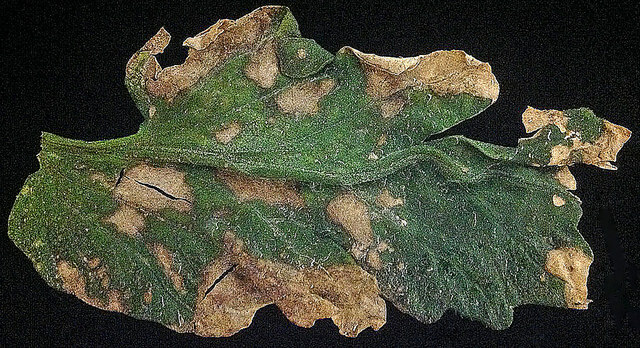
Anthracnose symptoms on tomato leaf

Anthracnose on tomato fruit

Anthracnose on tomato fruit
Symptoms
Fruit symptoms are the most common although stem, leaves and roots can also be infected; disease causes characteristic sunken circular lesions on the fruit; the indentations on may have visible concentric brown and yellow rings; lesion centers turn tan in color as they mature and become dotted with small black fungal fruiting bodies (microsclerotia); lesions can grow very large
Cause
Fungus
Comments
Management
Avoid sprinkler irrigation when fruit is ripening; rotate crops with other non-solanaceous plants
Black mold
Alternaria alternata
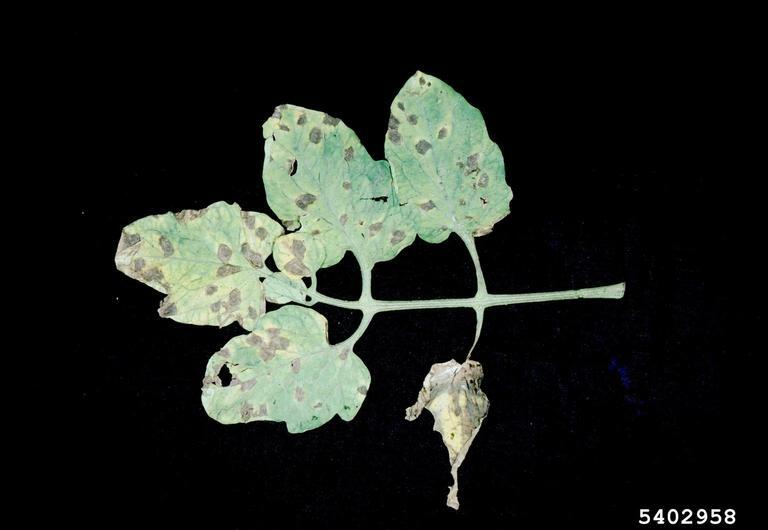
Black mold infected tomato leaves
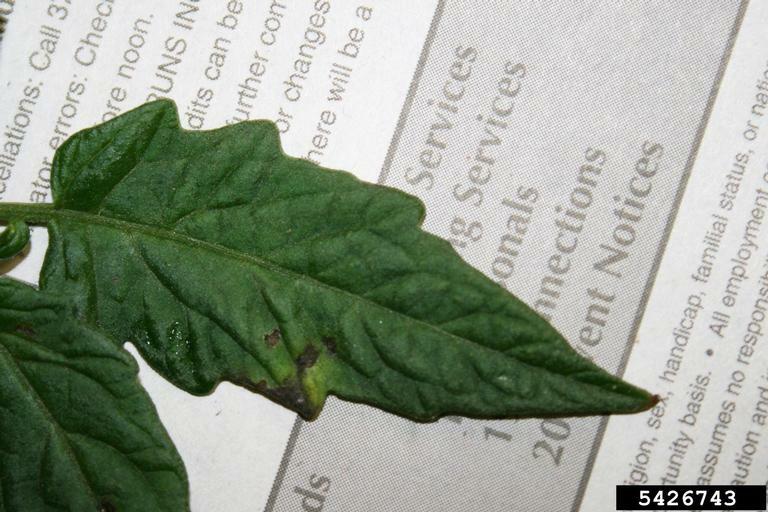
Alternaria black molds / stem cankers (Alternaria spp.) leaf symptoms: dark brown to black areas of tissue
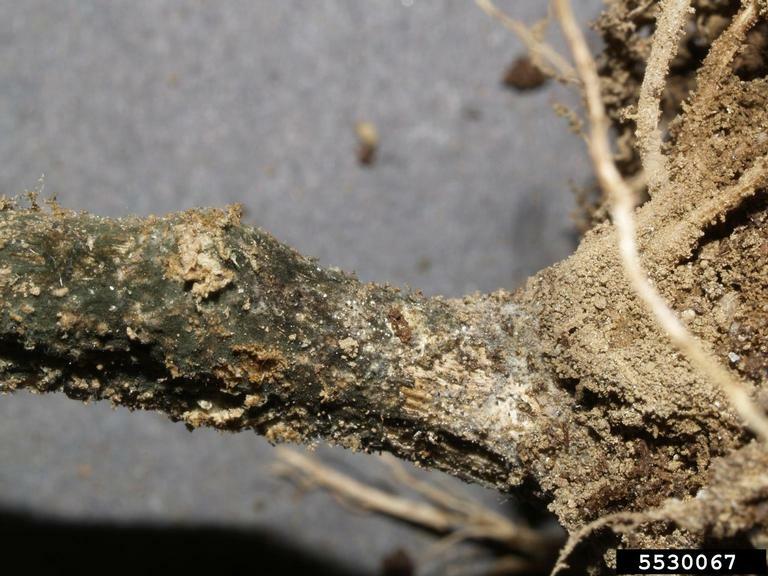
Canker at the base of plant, blackish growth of Alternaria conidia

Black mold symptom

Alternaria black molds / stem cankers (Alternaria spp.) canker at the base of plant
Symptoms
Disease causes the appearance of black or brown lesions on the surface of ripe fruit; lesions may be tiny flecks or may be large patches of decaying tissue; during periods of humid weather, the lesions may become covered in black, velvety spore masses.
Cause
Fungus
Comments
Management
Cultural control methods such as avoiding wetting the foliage when watering and harvesting fruits as soon as they are ripe can help to reduce the incidence of the disease; in areas where disease is a persistent problem, chemical control may be necessary with an appropriate fungicide; fungicide is usually applied 4-6 weeks prior to the first anticipated fruit harvest.
Early blight
Alternaria solani
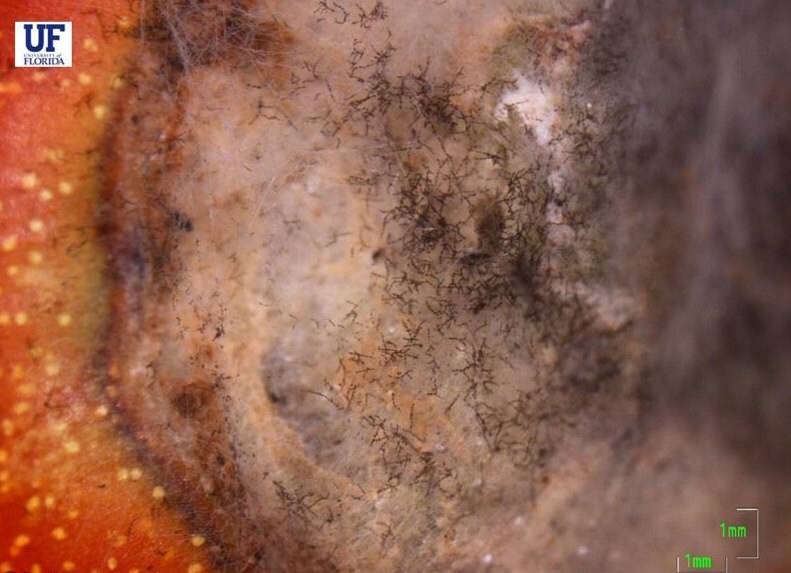
Sporulation from an infected fruit lesion. The fungus survives on infected tomato debris

A dark lesion at the shoulder of the fruit
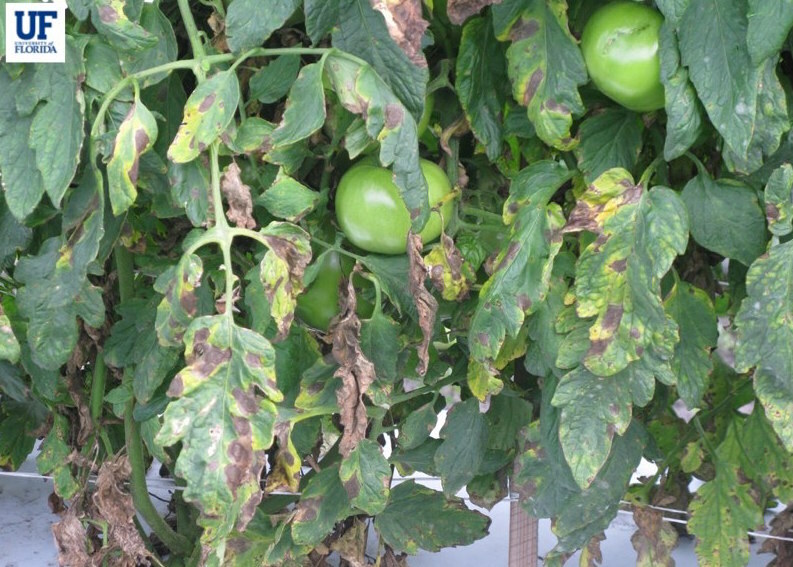
Severely blighted leaves

Concentric leaf lesions can be seen on infected leaves

Close up of early blight leaf lesion

Early blight symptoms on tomato stem

A fruit in the field with severe infection

Fruit symptoms include small black v-shaped lesions at the shoulders of the fruit
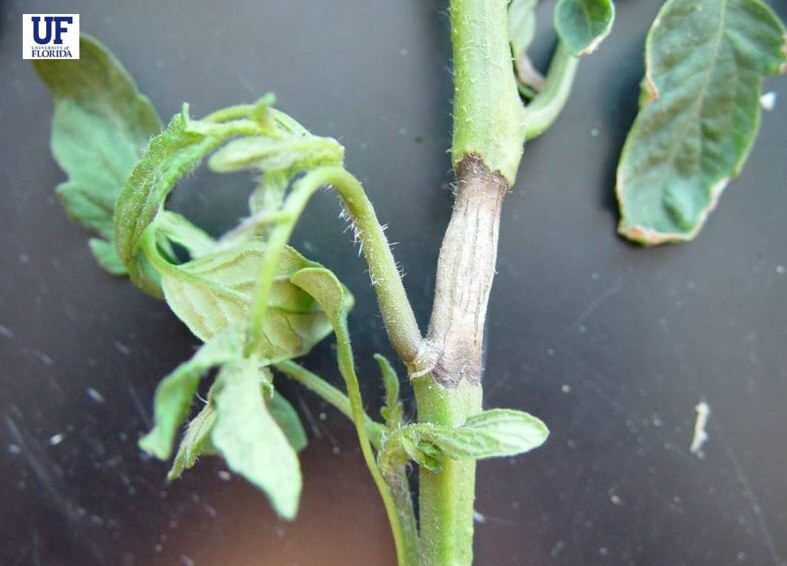
The canker may enlarge to girdle the whole stem

Oval shaped lesions with a yellow chlorotic region
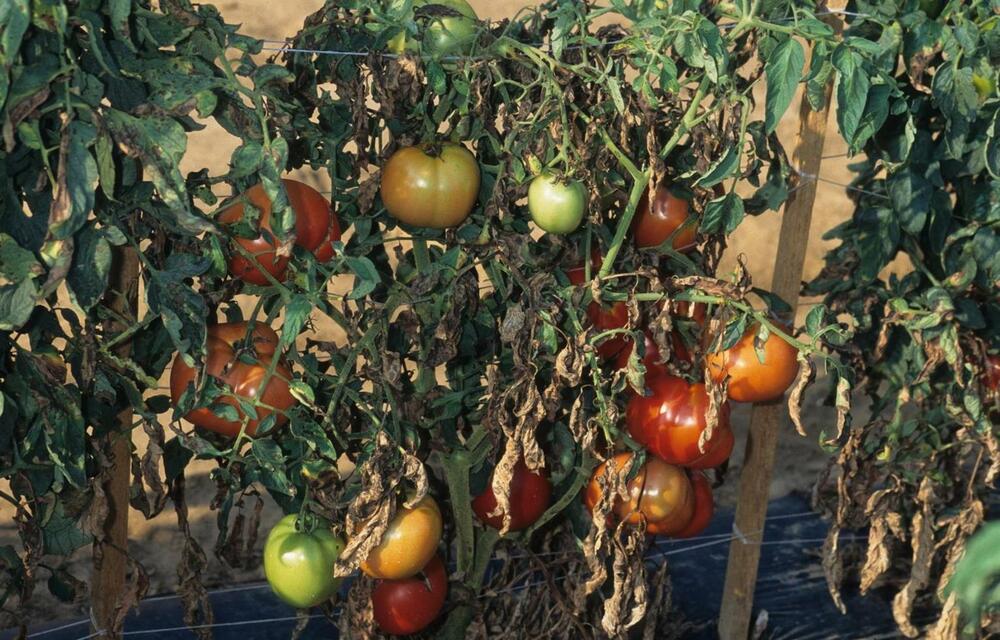
Blighted tomato plants
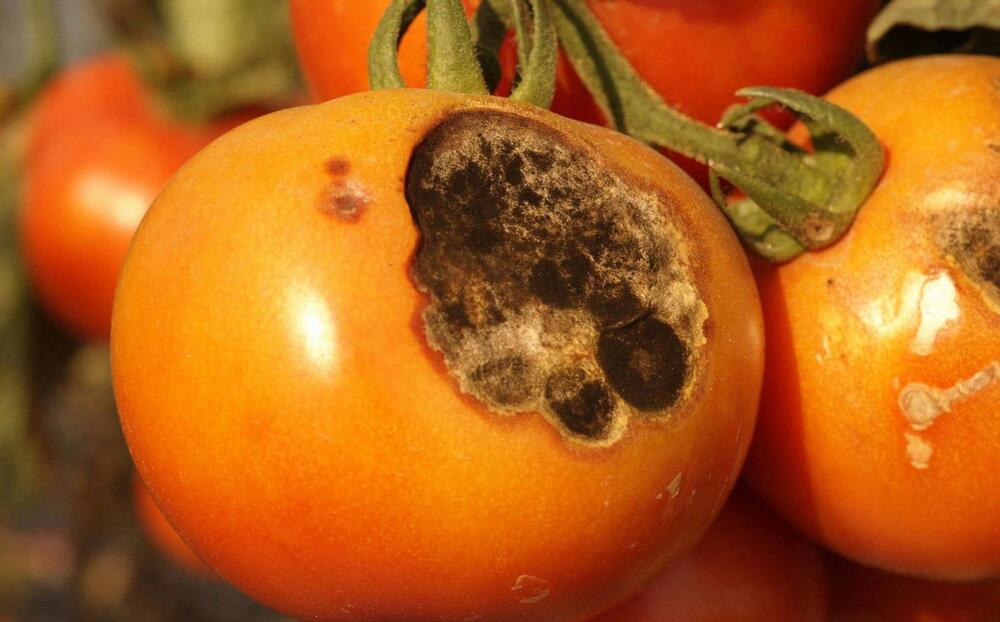
Early blight symptoms on tomato fruit

A chain of Alternaria spores
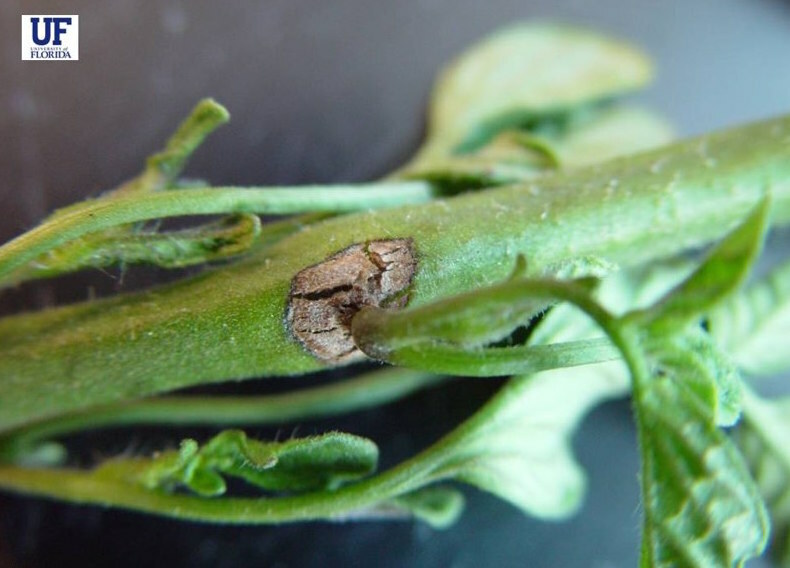
Alternaria stem canker symptoms

The leaves completely collapse in severe infection.

Early blight symptoms on tomato foliage

Early blight symptoms on tomato foliage
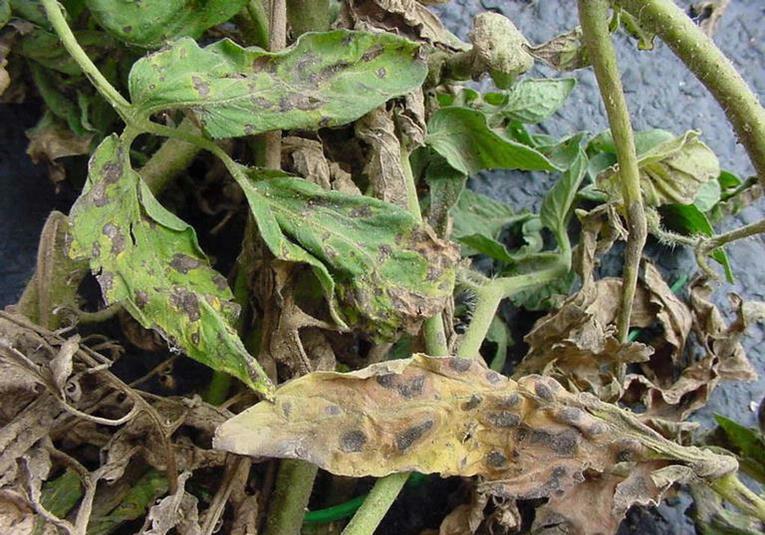
Early blight symptoms on tomato foliage
Symptoms
Early blight symptoms start as oval shaped lesions with a yellow chlorotic region across the lesion; concentric leaf lesions may be seen on infected leaves; leaf tissue between veins is destroyed; severe infections can cause leaves to completely collapse; as the disease progresses leaves become severely blighted leading to reduced yield; tomato stems may become infected with the fungus leading to Alternaria stem canker; initial symptoms of of stem canker are the development of dark brown regions on the stem; stem cankers may enlarge to girdle the whole stem resulting in the death of the whole plant; brown streaks can be found in the vascular tissue above and below the canker region; fruit symptoms include small black v-shaped lesions at the shoulders of the fruit (the disease is also known black shoulder); lesions may also appear on the fruit as dark flecks with concentric ring pattern; fruit lesions can seen in the field or may develop during fruit transit to the market; the lesions may have a velvety appearance caused by sporulation of the fungus
Cause
Fungus
Comments
Management
Apply appropriate fungicide at first sign of disease; destroy any volunteer solanaceous plants (tomato, potato, nightshade etc); practice crop rotation
Fusarium wilt
Fusarium oxysporum
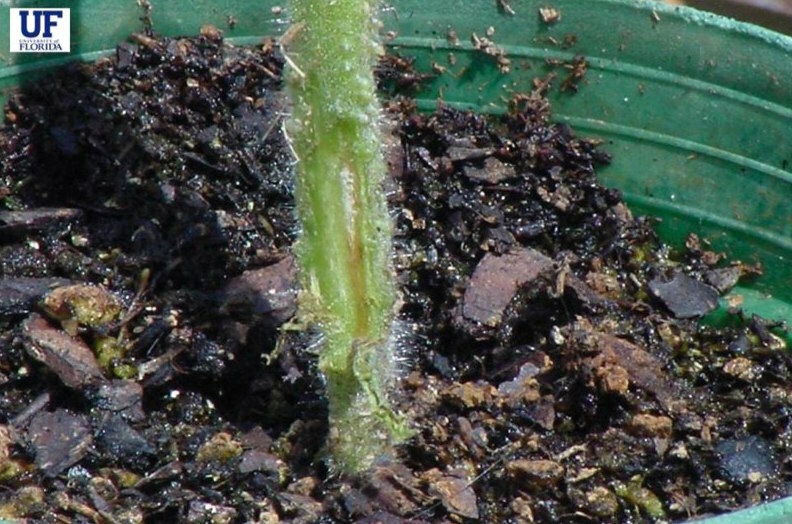
Seedling showing browning of the vascular system

Whole plant dying

Wilting tomato plants

Wilting tomato plants with characteristic yellow discoloration at top of plant
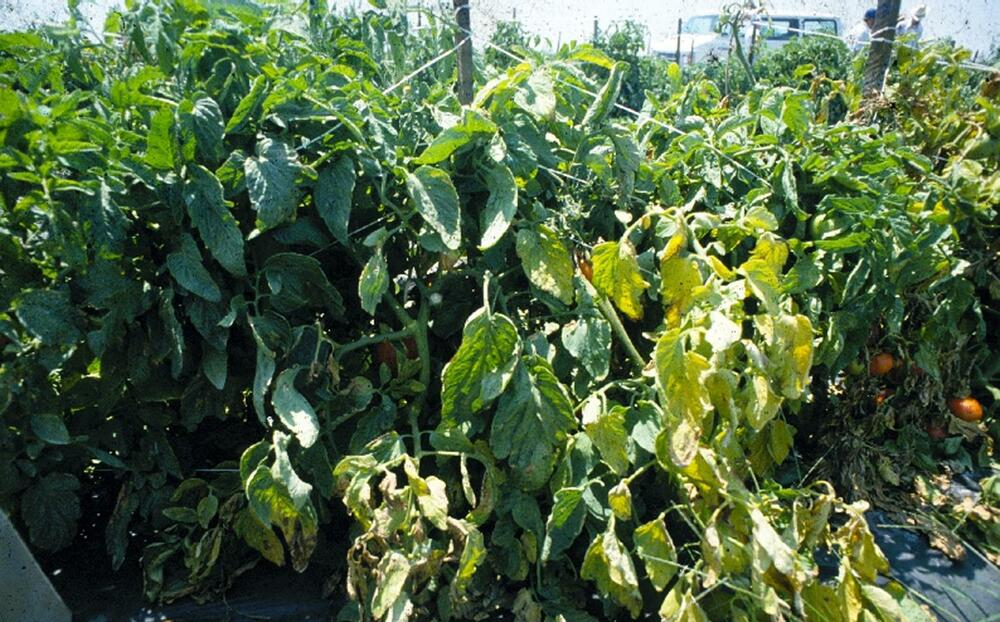
Symptoms of fusarium wilt on tomato foliage

Yellowing of the leaves on one side of the plant

Fusarium wilt symptoms may appear on one half of an infected plant indicating the blockage in the vascular system on that side

Fusarium wilt in tomato field

Collapse of tomato plant infected with Fusarium wilt

Discolored tomato stem tissue caused by fusarium wilt

Yellowing, wilting, and necrosis of older leaves on one side of the plant
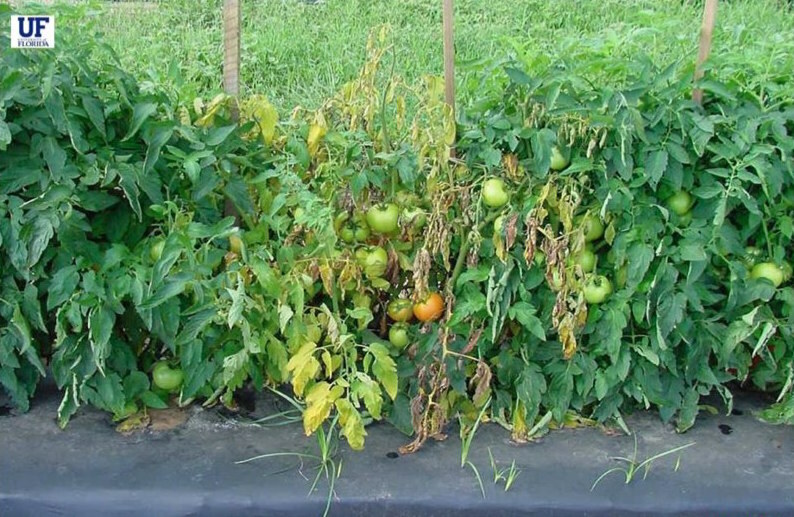
Plants infected with Fusarium wilt

Vascular discoloration caused by Fusarium wilt infection
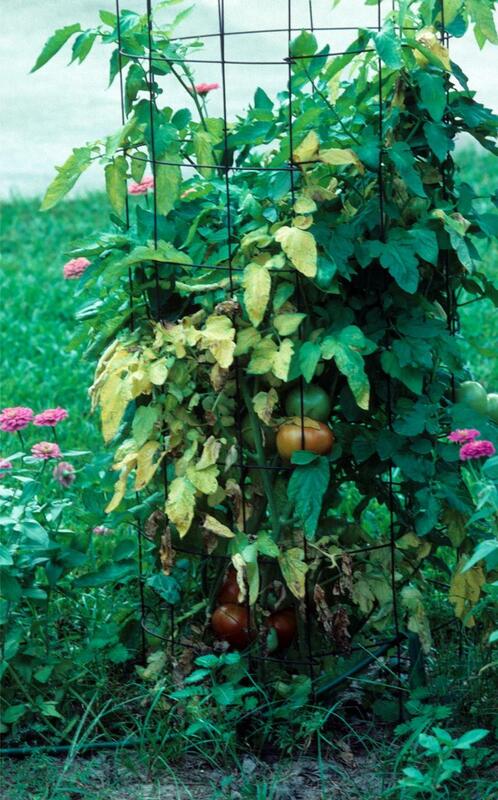
Symptoms of fusarium wilt on tomato foliage
Symptoms
Symptoms of Fusarium wilt may first appear as yellowing and wilting of leaves on one side of the leaf midrib or plant; one-sided symptoms are caused by a blockage in the vascular system supplying the symptomatic side of the plant; as the disease progresses, older leaves become necrotic and the plant begins to wilt; fruit on infected plants is smaller and yield is reduced; damage to leaves makes fruit susceptible to sunscald; stem symptoms may be mistaken for bacterial wilt but a bacterial ooze test will be negative; stem tissue becomes discolored brown
Cause
Fungus
Comments
Management
Plant resistant varieties; sanitize all equipment regularly; control root knot nematodes; rotate crops away from tomato for several years
Gray mold (Botrytis blight)
Botrytis cinerea
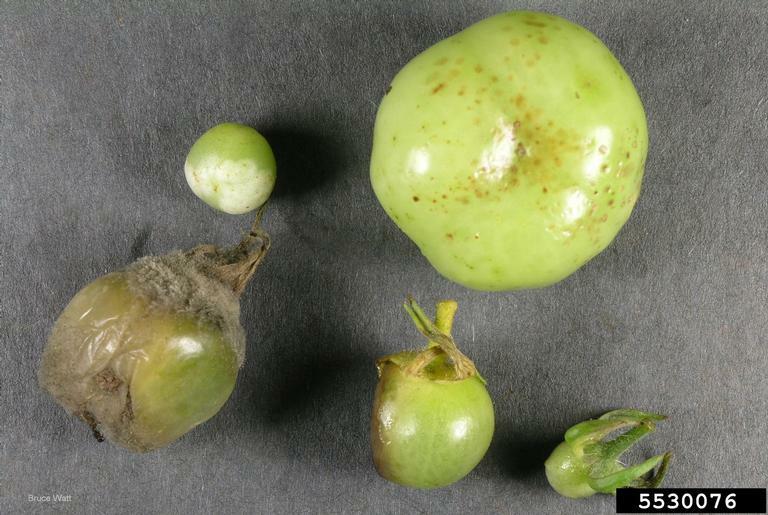
Infected fruit

Infected foliage

Infected stem

Gray mold symptoms on tomato fruit

Sporulation on infected stem
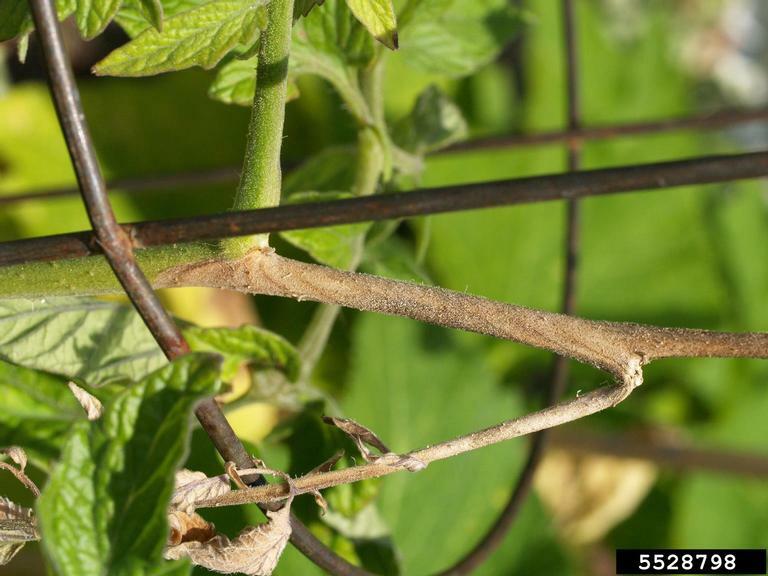
Symptoms on stem

Gray mold symptoms on tomato stem

Infected stem

Gray molds infected stem

Gray mold symptoms on tomato stem
Symptoms
Disease appears on tomato seedlings at or just below the soil line as a fuzzy gray-brown lesion which often girdles the stem, if stem is girdled all parts of the plant above the lesion begin to wilt; infected flowers and calyxes become covered in gray spores; unripe fruit turns light brown or gray in color and rots; green fruit infected by airborne spores develop circular white rings called “ghost spots”.
Cause
Fungus
Comments
Management
Liming soil to increase calcium content can help to reduce plant susceptibility to gray mold; application of appropriate fungicide prior to formation of dense canopy.
Leaf Mold
Passalora fulva

Leaf mold symptoms
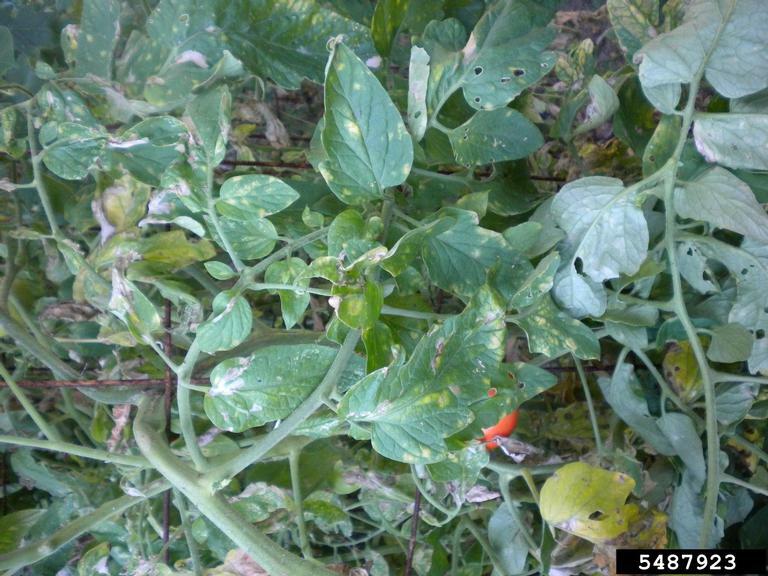
Yellow spots due leaf mold

Yellow areas on upper leaf surface

Close-up of moldy growth on underside of leaf spot.

Brown leaf spots on upper leaf surface
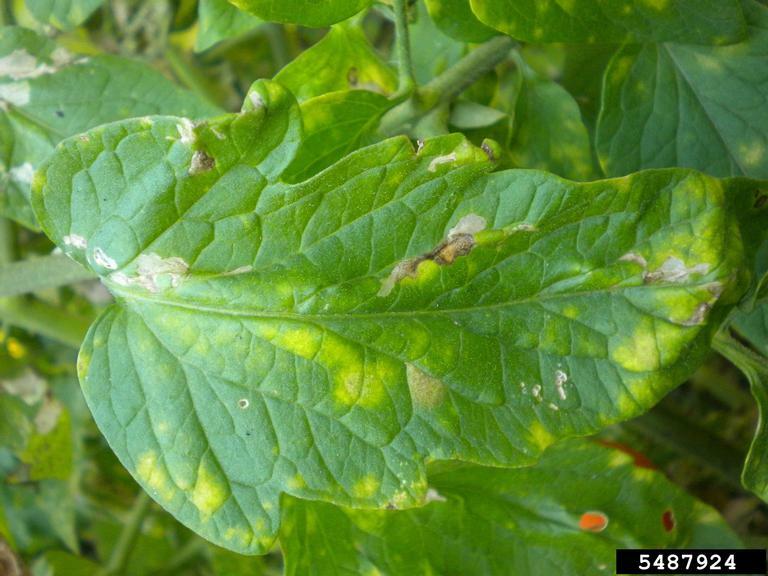
Yellow spots
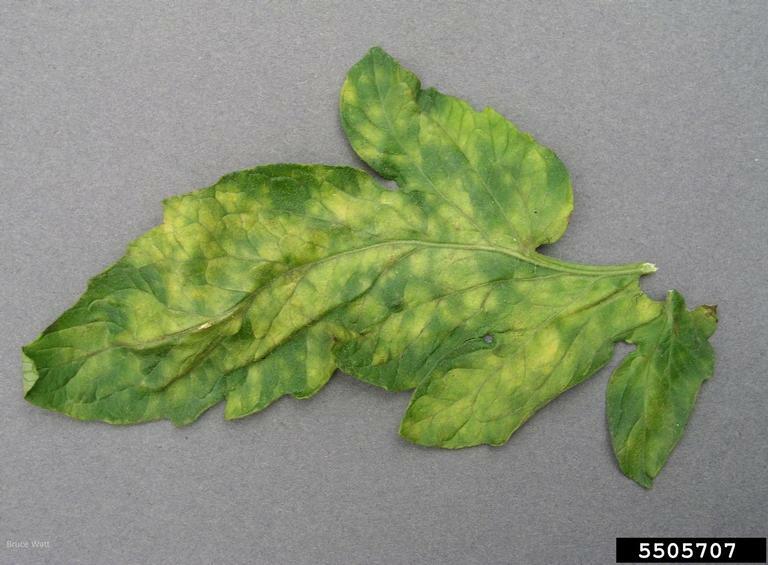
Infected leaf, upper side
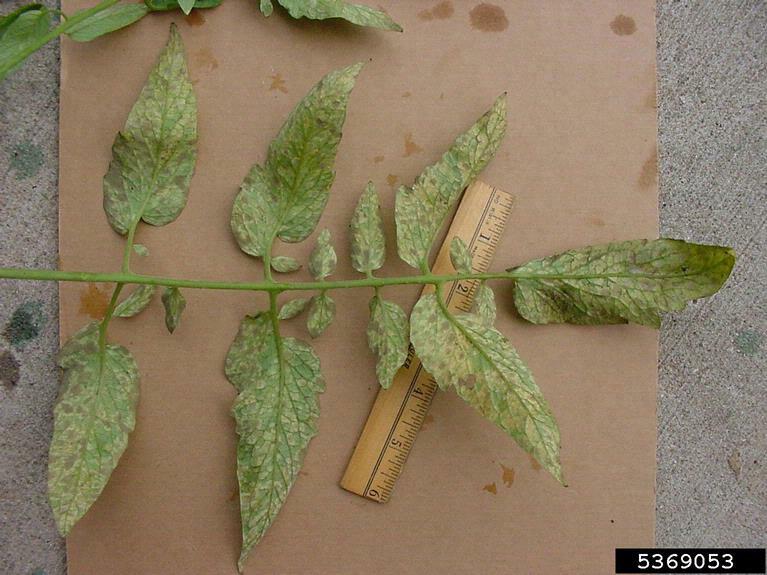
Spots look diffuse on lower leaf surface.

Leaf spots and sporulation on underside of leaf

Symptoms on lower surface

Brown, felt-like patches of conidia on lower leaf surface
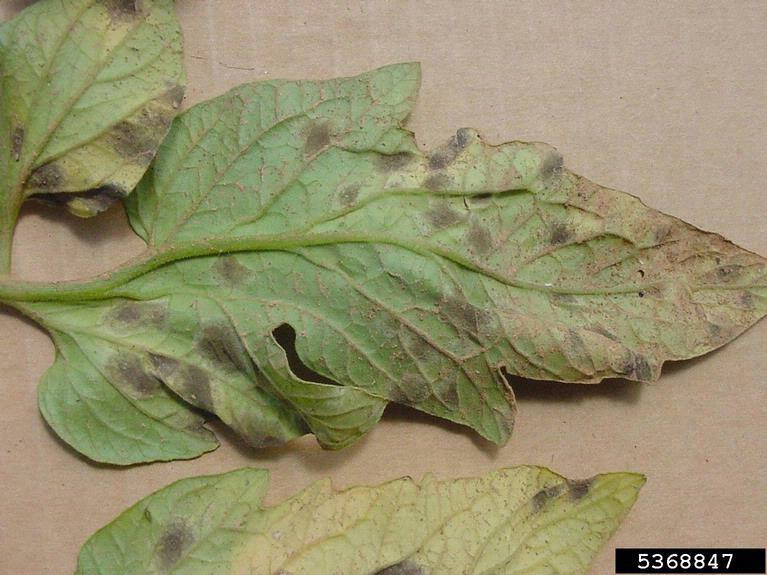
Spots look diffuse with fuzzy growth on lower leaf surface.

Spots on upper leaf surface due to leaf mold fungus

Symptoms on leaf mold infected fruits

Leaf mold symptoms on lower leaf surface
Symptoms
The older leaves exhibit pale greenish to yellow spots (without distinguishable margins) on upper surface. Whereas the lower portion of this spots exhibit green to brown velvety fungal growth. As the disease progress the spots may coalesce and appear brown. The infected leaves become wither and die but stay attached to the plant. The fungus also infects flowers and fruits. The affected flowers become black and drop off. The affected fruit intially shows smooth black irregular area on the stem end but later it becomes sunken, leathery and dry.
Cause
Fungus
Comments
Management
Grow available resistant varieties. Avoid leaf wetting and overhead application of water. Follow proper spacing to provide good air circulation around the plants. Remove the infected plant debris and burn them. If the disease is severe scary suitable fungicide.
Septoria leaf spot
Septoria lycopersici

Septoria leaf spot symptoms on tomato foliage

Close-up of leaf lesion showing gray-white center with fungal fruiting bodies

Septoria leaf spot lesion on tomato leaf

Septoria leaf spot symptoms on tomato foliage

Symptoms of Septoria leaf spot on tomato foliage
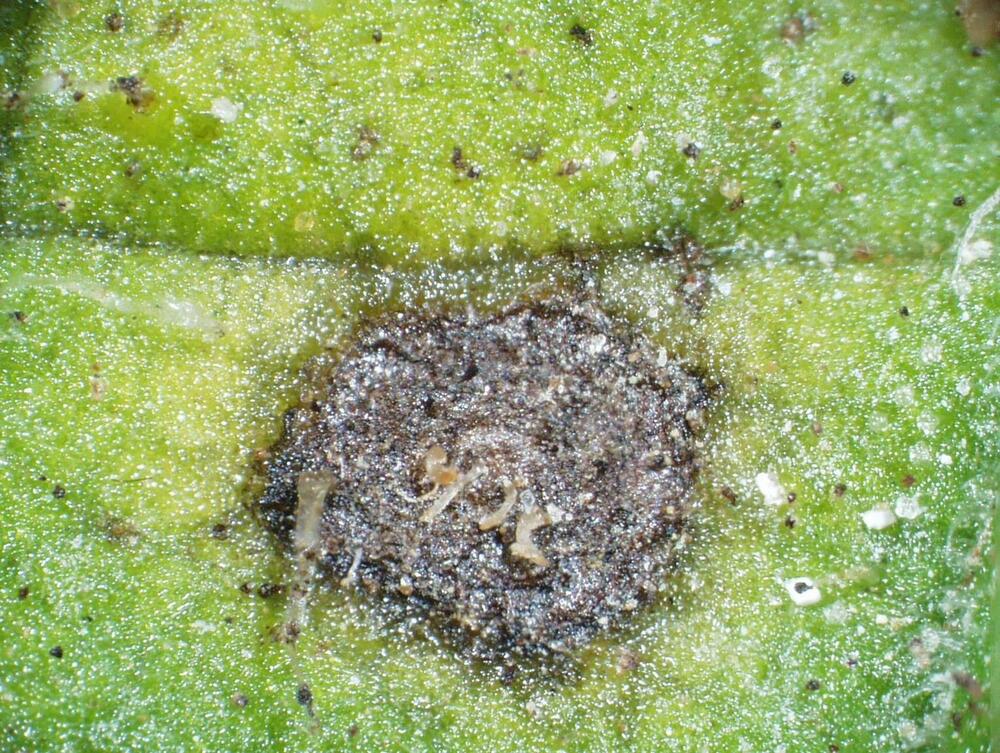
Close-up of a Septoria lesion on tomato

Septoria leaf spot symptoms on tomato leaf
Symptoms
Symptoms may occur at any stage of tomato development and begin as small, water-soaked spots or circular grayish-white spots on the underside of older leaves; spots have a grayish center and a dark margin and they may colasece; fungal fruiting bodies are visible as tiny black specks in the center of spot; spots may also appear on stems, fruit calyxes, and flowers.
Cause
Fungus
Comments
Management
Ensure all tomato crop debris is removed and destroyed in Fall or plowed deep into soil; plant only disease-free material; avoid overhead irrigation; stake plants to increase air circulation through the foliage; apply appropriate fungicide if necessary.
Target Spot
Corynespora cassiicola
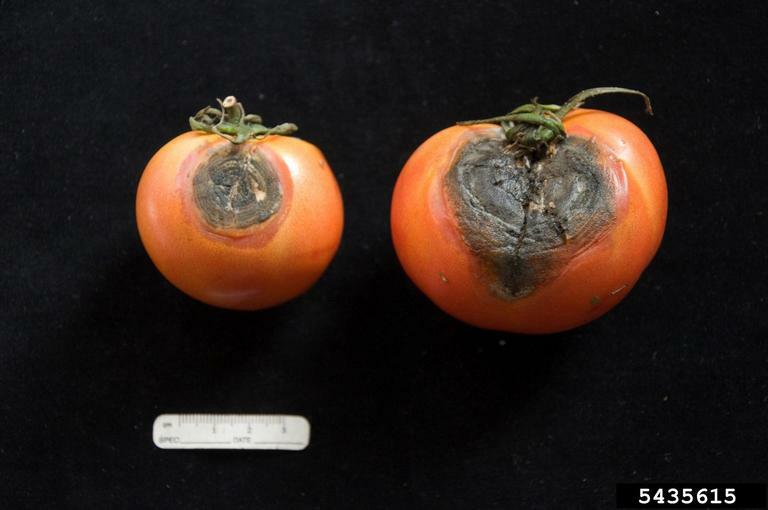
Black lesions with conidia
Symptoms
The fungus infects all parts of plant. Infected leaves shows small, pinpoint, water soaked spots initially. As the disease progress the spots enlarge to become necrotic lesions with conspicuous concentric circles, dark margins and light brown centers. Whereas the fruits exhibit brown, slightly sunken flecks in the beginning but later the lesions become large pitted appearance.
Cause
Fungus
Comments
Management
Remove the plant debris and burn them. Avoid over application of nitrogen fertilizer. If the disease is severe spray suitable fungicides.
Verticillium wilt
Verticillium albo-atrum
Verticillium dahliae
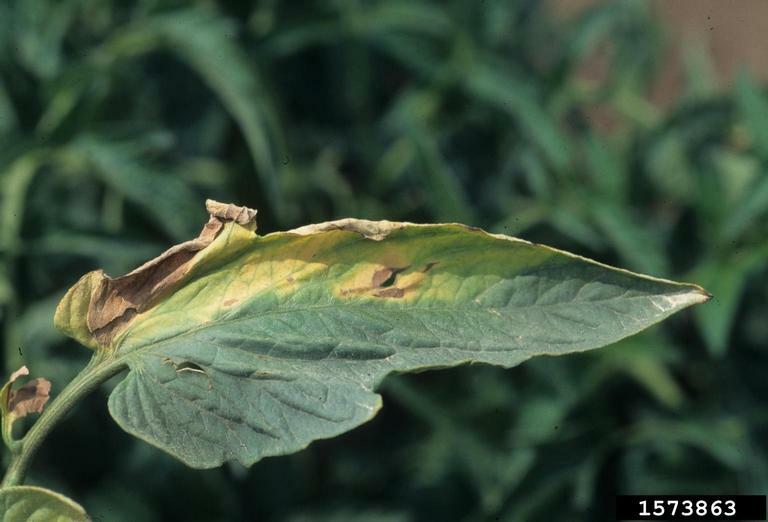
Close up of distinctive, one-sided chlorotic leaf

Single leaf showing necrosis and chlorosis.

Verticillium wilt symptoms on tomato leaf

Single leaf showing v-shaped necrosis

Single leaf showing v-shaped necrosis and chlorosis.

Verticillium wilt of tomato

Close up of distinctive, one-sided chlorotic leaf

Verticillium wilt symptoms on tomato foliage

Verticillium wilt symptoms on tomato leaf
Symptoms
Symptoms appear first on lower leaves and spread upwards; initial symptoms of the disease may be visible as yellow blotches on the lower leaves of the plant; a rapid yellowing of leaves follows as the disease progresses; leaf veins turn brown and brown dead spots appear on the leaves; leaves may wilt then die and drop from the plant; the disease progresses upwards through the stem causing the plant to be stunted; leaves at the top of the plant remain green; fruits develop yellow shoulders and yield is reduced; loss of leaves results in fruit being susceptible to sun scald.
Cause
Fungi
Comments
Management
Plant resistant varieties; sanitize all equipment on a regular basis; rotate with non-susceptible crops.
Category : Bacterial
Bacterial canker
Clavibacter michiganensis
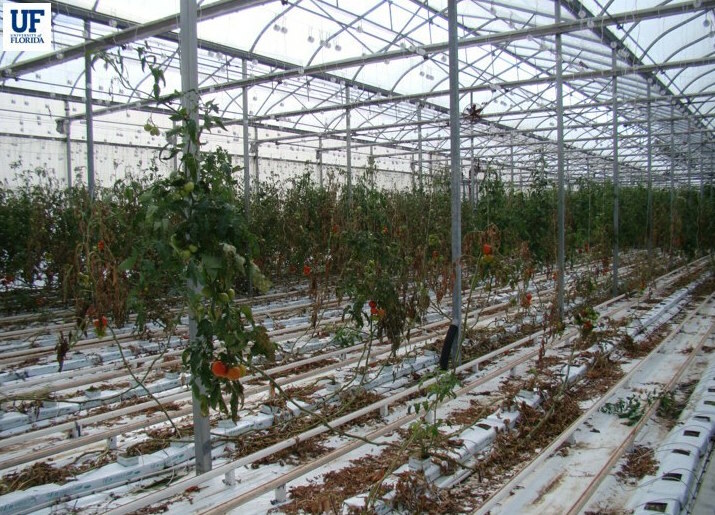
A disease in rapid progress killing large sections of plants in a greenhouse

Netted appearance of fruits on symptomatic plants

Infected stem can be noticed when cut open

Vascular discoloration of the stem of infected plants

Raised spots on unripe fruit
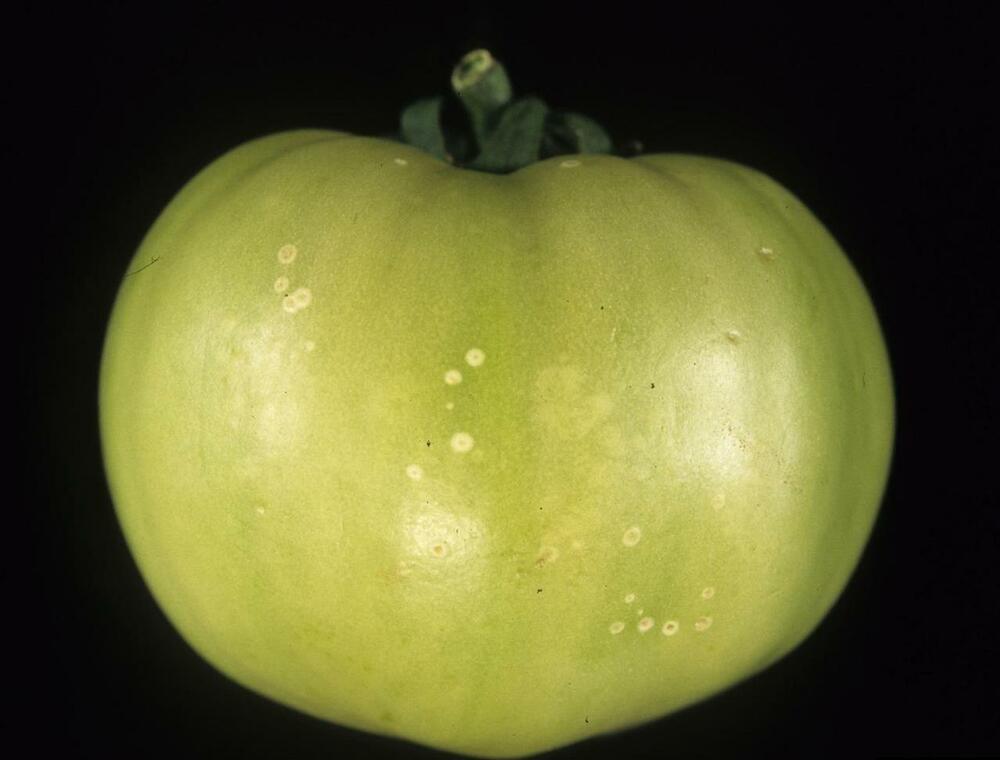
Raised spots on unripe fruit

Bacterial canker and wilt of tomato

Lesions on the fruit has a bird’s eye appearance
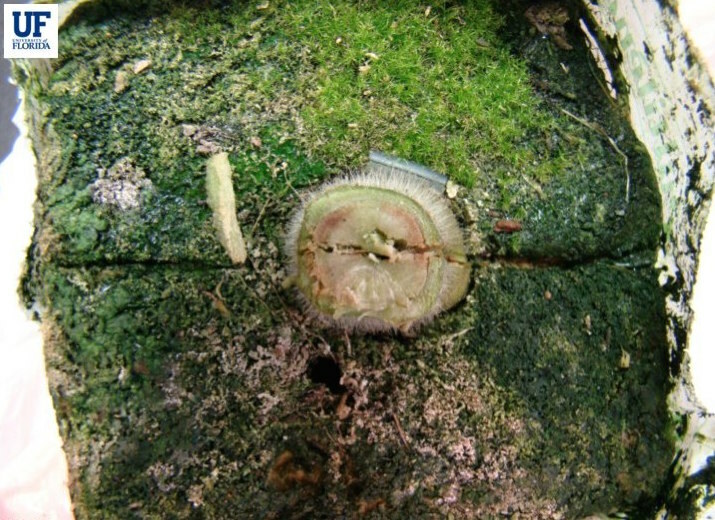
A cut portion of the stem indicating discoloration

Leaf blighting spreading across a row in greenhouse production

Progression of the symptoms on the entire plant in a greenhouse facility

Foliar symptoms of bacterial canker and wilt
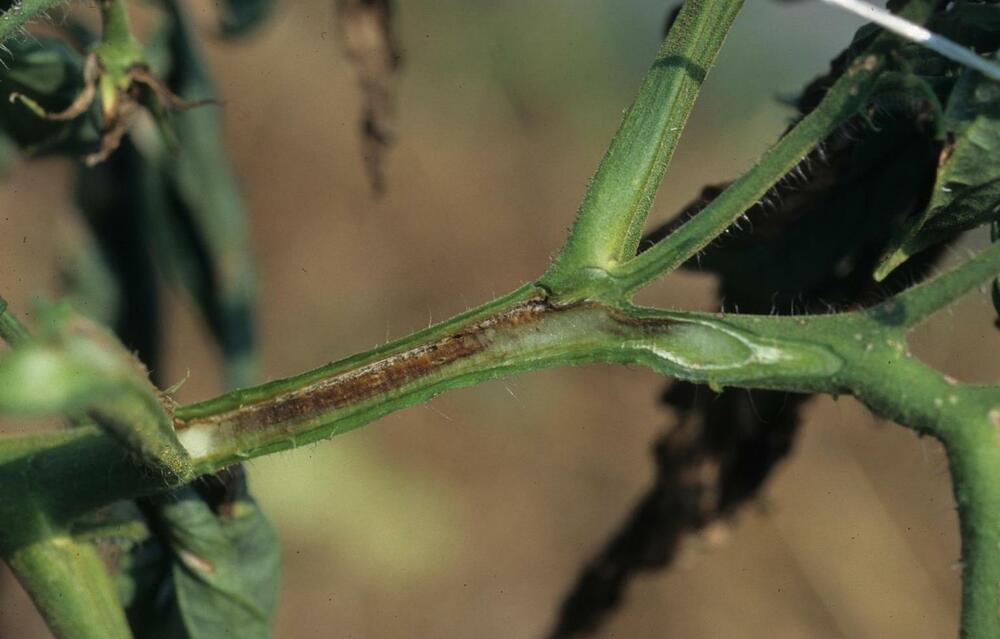
Symptoms of bacterial canker and wilt on tomato stems
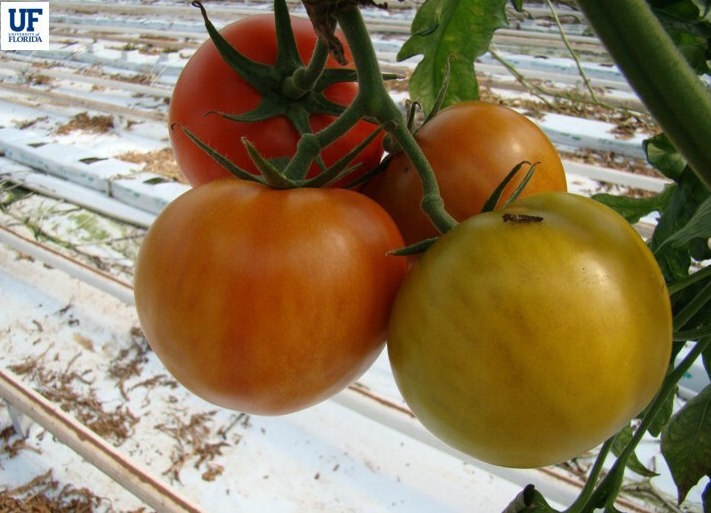
Ripe fruits with netted appearance

Severe leaf blighting under extremely high disease incidence
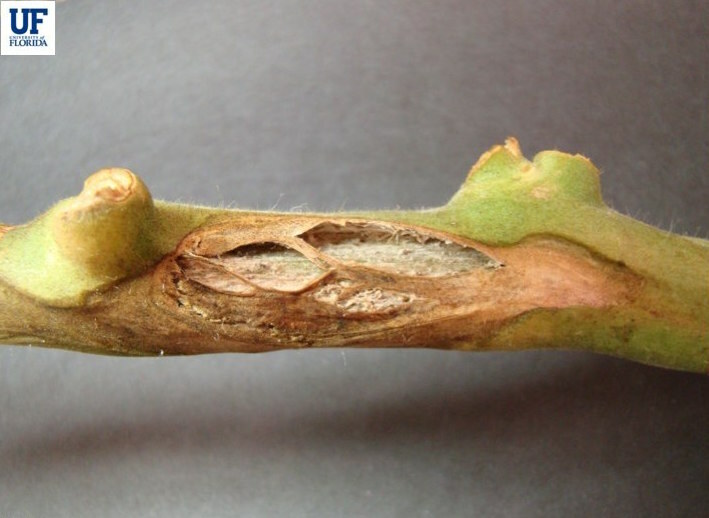
Canker on the infected stem

The first symptom is the unilateral wilting of plants and formation of light colored streaks up on leaf midribs, petioles and stems

Foliar symptoms of bacterial canker and wilt

Symptoms of bacterial canker and wilt on tomato fruit
Symptoms
Bacterial canker can affect tomato plants of any age, seedlings may be killed quickly once they become infected; initial symptoms of bacterial canker is the unilateral wilting of plants and formation of light colored streaks up and down the outside of the leaf midrib, petiole and stem; streaks on stems may break open to form cankers; mature leaves develop small necrotic spots on the upper leaf surfaces or small raised white spots on the leaves; white spots develop on fruit, usually while they are still green; spots on fruit develop a raised dark center and are known as "bird's eye spots"
Cause
Bacterium
Comments
Management
Plant only certified seed and transplants; hot water treatment of seed to remove bacteria; rotate crops with non-host plants; turn crops into soil after harvest to promote decomposition
Bacterial speck
Pseudomonas syringae
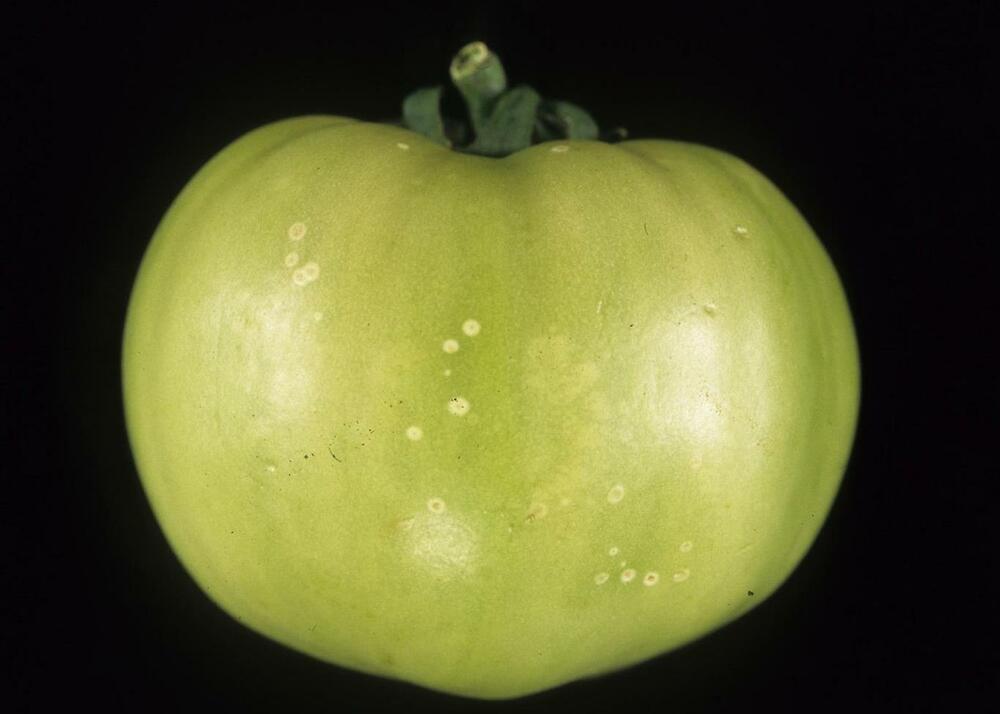
Spots on tomato fruit caused by bacterial speck
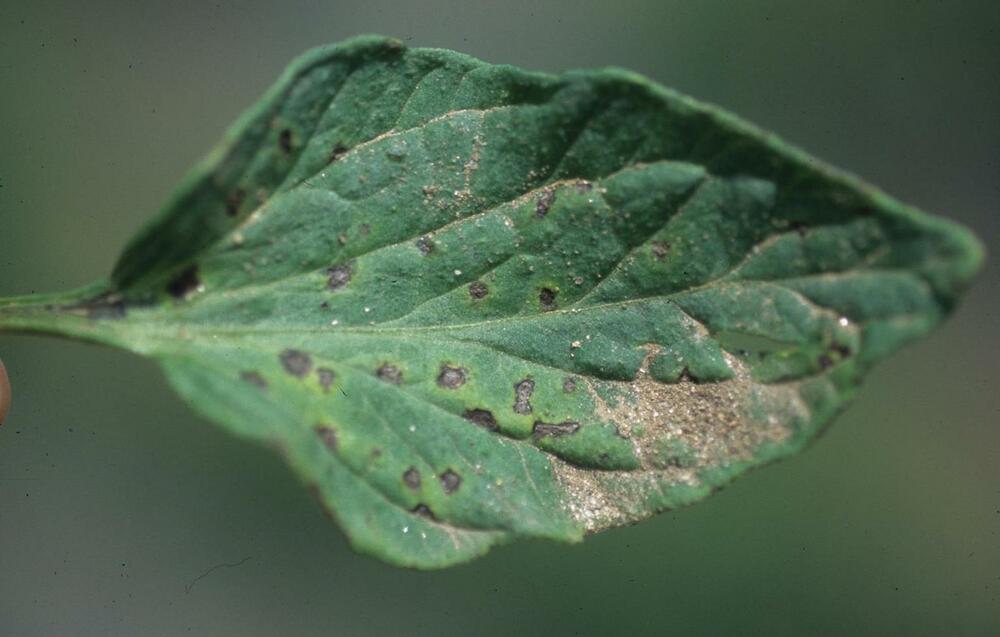
Bacterial speck on tomato leaf

Bacterial speck on tomato leaf

Bacterial speck on tomato leaf

Bacterial speck on tomato leaf
Symptoms
Dark specks appear on the leaves, often associated with a yellow halo; foliar symptoms of bacterial speck are very difficult to distinguish from bacterial spot but can be differentiated by symptoms on the fruit; lesions on fruit are much smaller than those caused by bacterial spot; lesions on fruit are raised and scaly.
Cause
Bacterium
Comments
Management
Do not plant in same area in successive years; use only high quality, disease-free seed and transplants; protective sprays of copper can help to reduce incidence of the disease.
Bacterial spot
Xanthomonas campestris pv. vesicatoria
Xanthomonas euvesicatoria
Xanthomonas perforans = [Xanthomonas axonopodis (syn. campestris) pv. vesicatoria], Xanthomonas vesicatoria
Xanthomonas gardneri

Leaves will ooze from the cut end only in case of bacterial spot
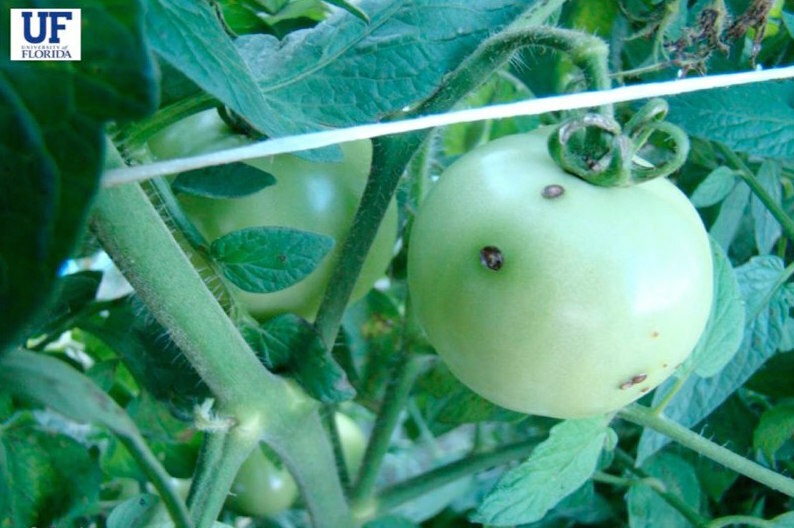
Lesions on the fruit can also be raised around the margins and sunken in the middle
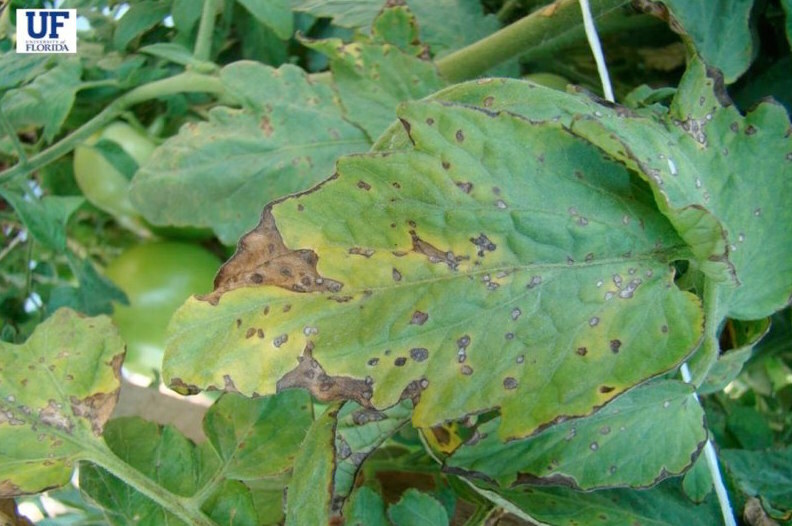
Lesions may coalesce forming necrotic areas on the leaf giving it a blighted appearance
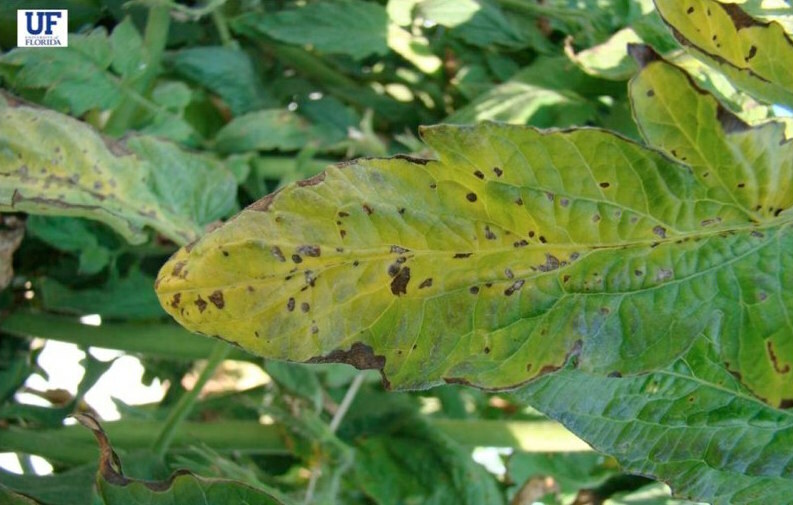
Severe infections causes the leaves to look blighted
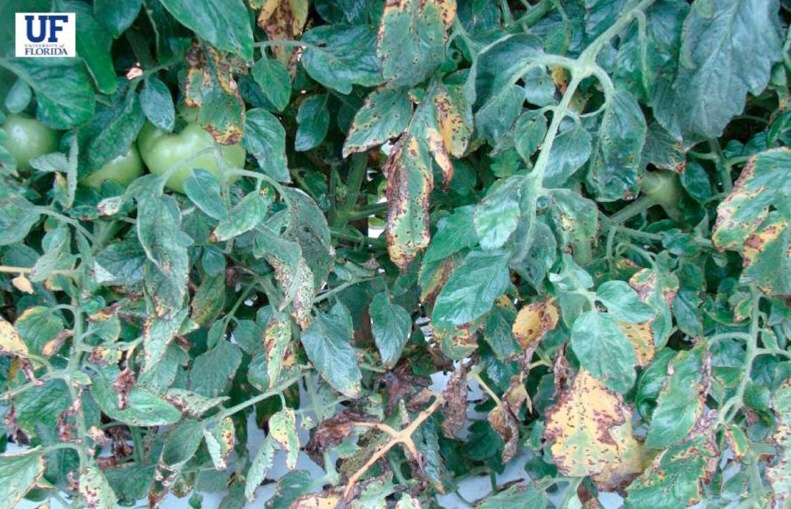
bacterial spot causes significant crop losses during rainy conditions

Symptoms of bacterial spot on tomato foliage

Symptoms of bacterial spot on tomato foliage

Bacterial spot symptoms on tomato foliage

Fruit spots can also be slightly raised and scabby looking

Fruit infections start as a slightly raised blister
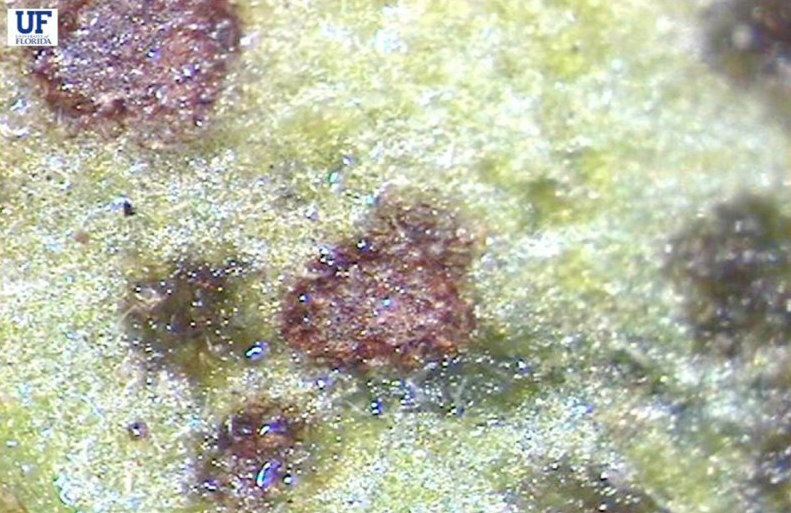
Mature spots, with or without yellowing have a greasy appearance and can be transparent
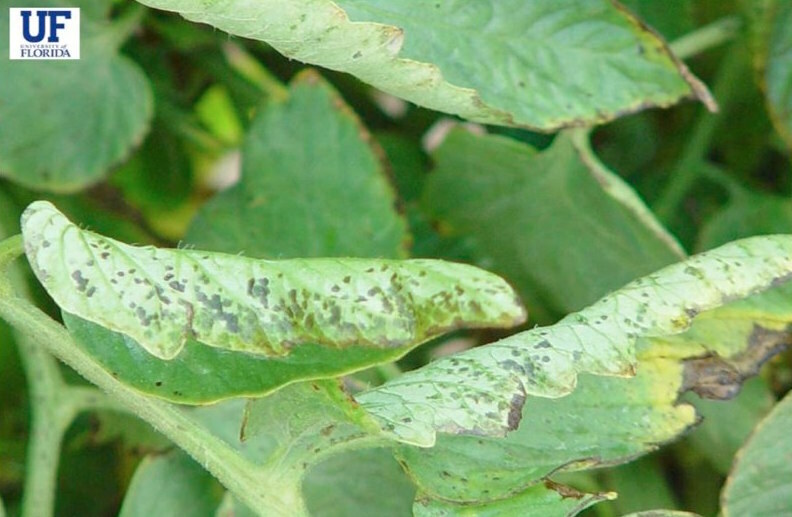
Bacterial spot lesions starts out as small water-soaked spots.
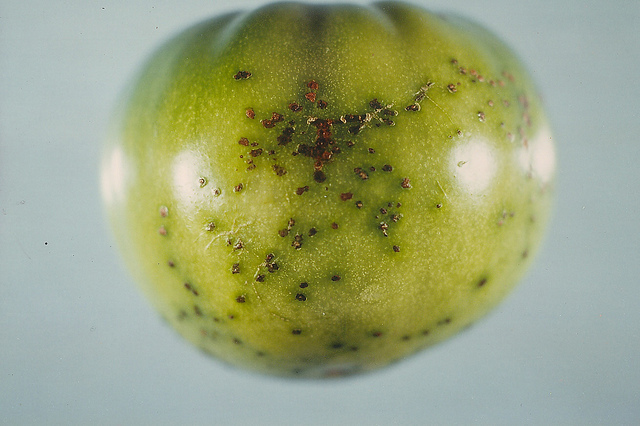
Symptoms of bacterial spot on tomato fruit

Symptoms of bacterial spot on tomato fruit

Symptoms of bacterial spot on tomato foliage
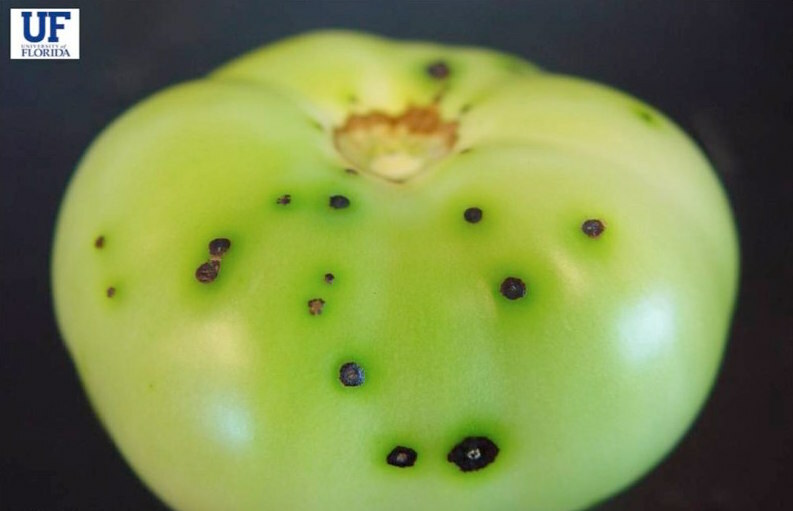
Lesions on the fruit can also be raised around the margins and sunken in the middle

Severe defoliation of infected plants can occur leading to a blighted look in large tomato fields

Petioles with spot lesions are turning yellow followed by complete necrosis

Symptoms of bacterial spot on tomato foliage

Symptoms of bacterial spot on tomato foliage

Symptoms of bacterial spot on tomato fruit

Bacterial spot symptoms on tomato fruit
Symptoms
Bacterial spot lesions starts out as small water-soaked spots; lesions become more numerous and coalesce to form necrotic areas on the leaves giving them a blighted appearance; of leaves drop from the plant severe defoliation can occur leaving the fruit susceptible to sunscald; mature spots have a greasy appearance and may appear transparent when held up to light; centers of lesions dry up and fall out of the leaf; blighted leaves often remain attached to the plant and give it a blighted appearance; fruit infections start as a slightly raised blister; lesions may have a faint halo which eventually disappears; lesions on fruit may have a raised margin and sunken center which gives the fruit a scabby appearance.
Cause
Bacterium
Comments
Management
Use only certified seed and healthy transplants; remove all crop debris from planting area; do not use sprinkler irrigation, instead water from base of plant; rotate crops.
Bacterial wilt
Ralstonia solanacearum
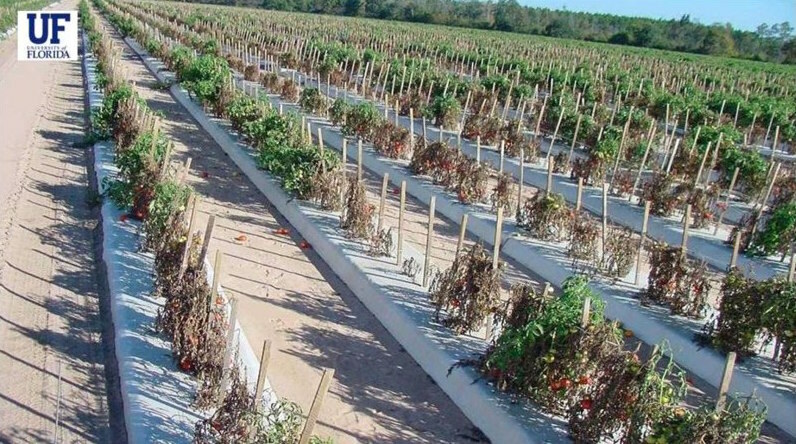
A field of tomato with high bacterial wilt incidence (80-90%)

Secondary spread through water movement to adjacent plants on both sides from an infected plant

Darkening of the vascular system
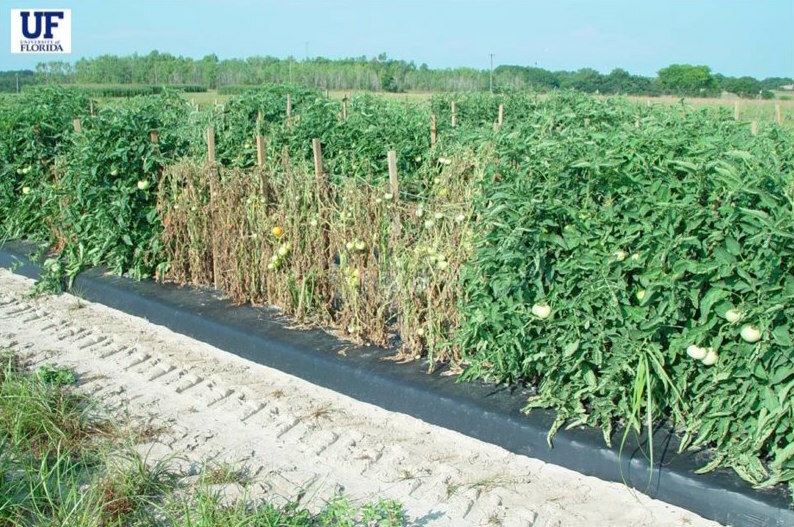
Large section of severely infected plants

Bacterial ooze from a freshly cut stem
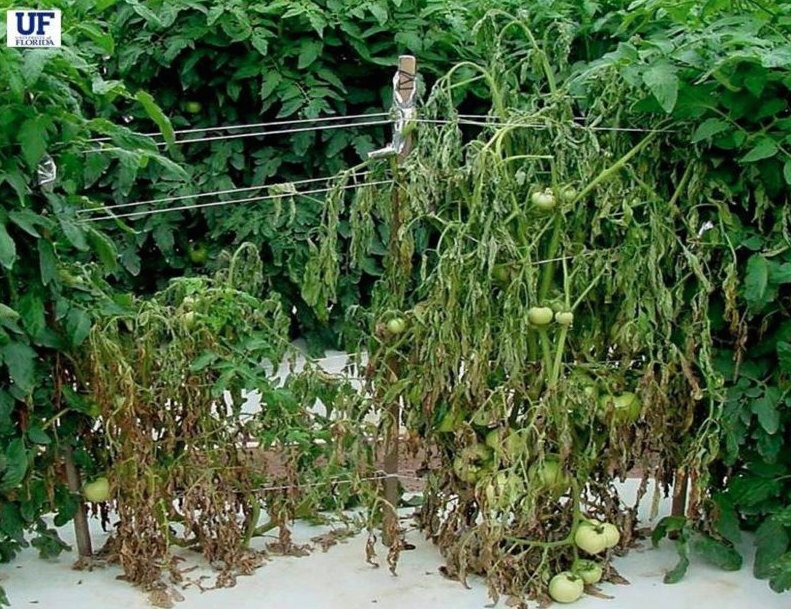
Severe symptoms of bacterial wilt

Severely wilted tomato plants

Surface of the stem is darkening and collapsing

Tomato plants infected with bacterial wilt
Symptoms
Initial symptoms of the disease is the wilting of a few of the youngest leaves; the disease progresses rapidly in hot weather and the entire plant wilts suddenly and dies; in cooler conditions, wilting is less rapid and plant may produce roots on the stems; vascular tissue shows a brown discoloration and decaying roots; stems cut under water will ooze bacterial exudate and will confirm the symptoms are not caused by Fusarium wilt.
Cause
Bacterium
Comments
Management
Cultural practices may help to reduce incidence of the disease, rotate tomato with other, non-susceptible crops; avoid over-watering plants.
Category : Other
Blossom-end rot

Internal symptoms of BER

BER on the side of the fruit

Light tan, water-soaked areas on tomato fruit
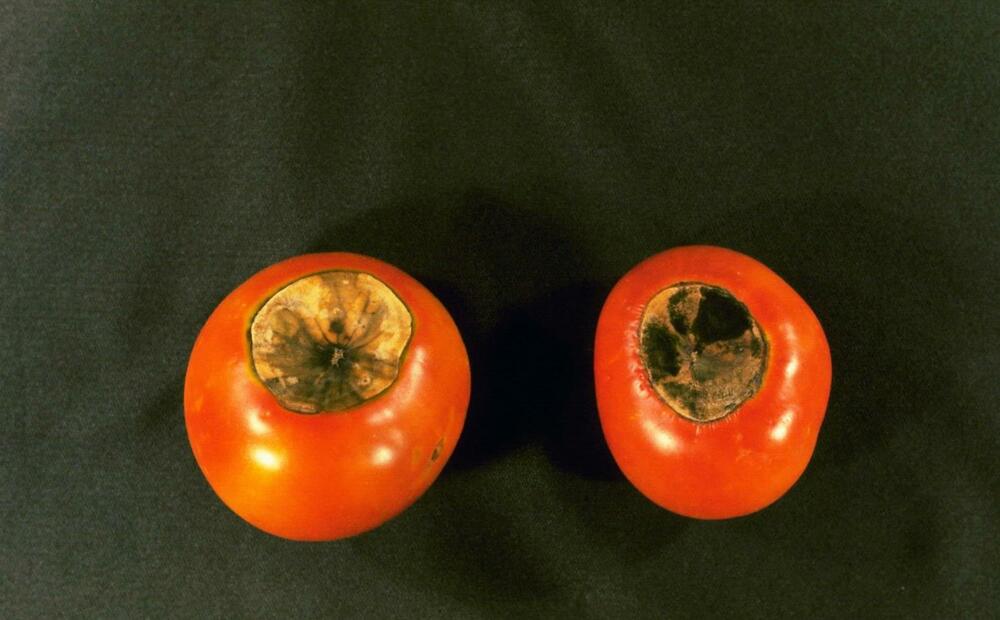
Blossom-end rot on tomato fruit

Blossom-end rot on tomato fruit

Blossom-end rot on tomato fruit

Blossom-end rot on tomato fruit

Blossom-end rot on tomato fruit

Blossom-end rot on tomato fruit
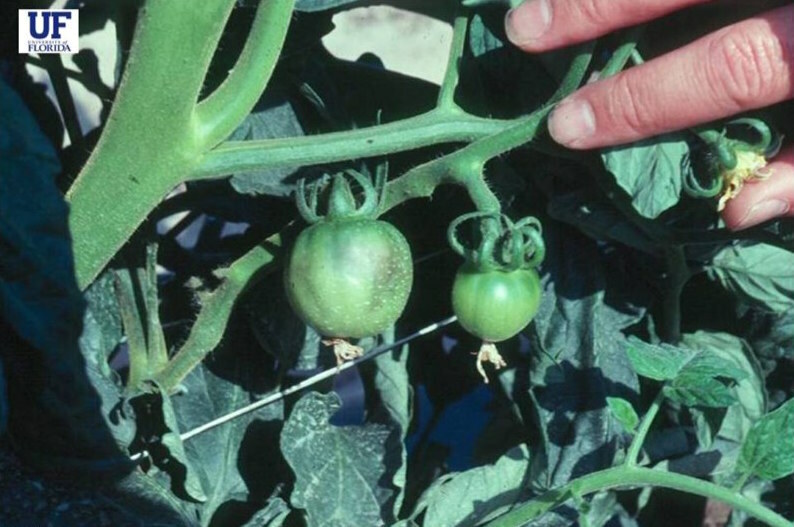
The problem often occurs at the blossom end of the fruit

Blossom-end rot on tomato fruit
Symptoms
Blossom end-rot is caused by a low concentration of calcium in the tomato fruit; symptoms initially appear as light tan, water-soaked areas which can then enlarge and turn black and leathery in appearance; symptoms are most often seen at the blossom end of the fruit, but may also occur on the side of the fruit; blossom-end rot may also occur internally with no visible symptoms on outside of fruit.
Cause
Physiological disorder.
Comments
Management
Maintain soil pH at 6.5; lime soil to increase the concentration of calcium in soil and decrease competition with other ions; use mulch to reduce drought stress; avoid ammonium fertilizers as they may increase competition with calcium by increasing ammonium ions in soil, use nitrate instead; avoid over fertilizing.
Catface

Catfacing

Catface symptoms

Catface symptoms

Catface symptoms

Catface symptoms
Symptoms
Catface usually occurs on the blossom end, tomato fruits are usually misshapen with large holes or corky brown scars close to the blossom end of the fruit; fruits are often flattened and may be kidney shaped; holes on the fruit extend deep inside the fruit.
Cause
Physiological disorder
Comments
Management
Avoid pruning tomato plants excessively; avoid excessive fertilization with nitrogen which promotes rapid vegetative growth; if growing tomatoes in a glasshouse, provide the plants with heat to prevent temperatures dropping to damaging levels, particularly at night.
Edema (Oedema)

Close-up of edema blister
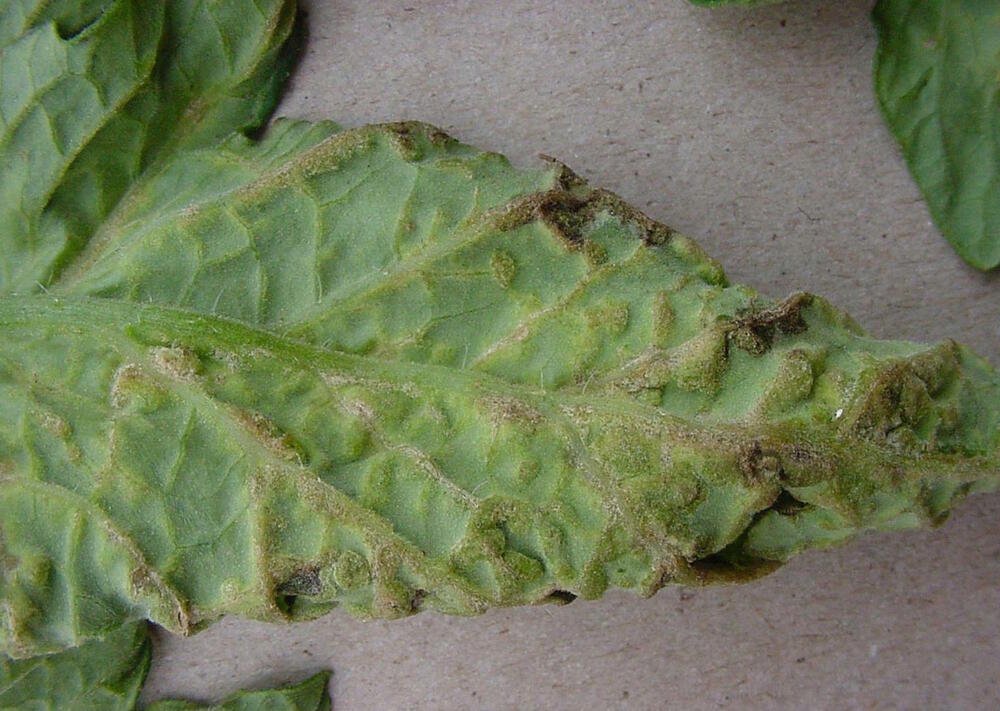
Symptoms of edema on tomato leaves
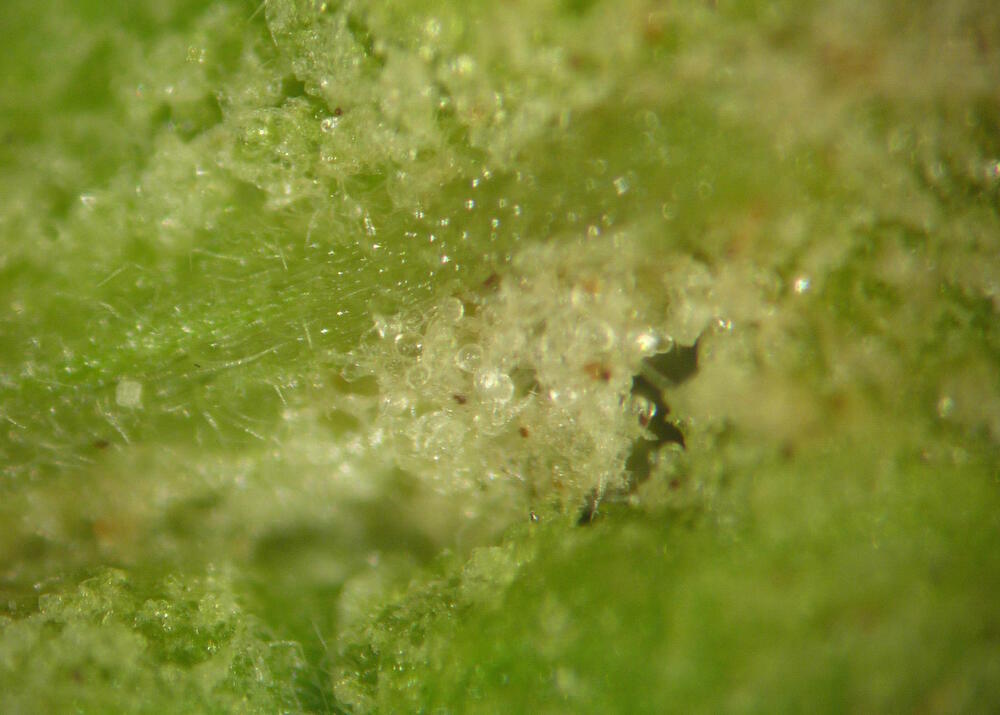
Close-up of edema blister

Edema symptoms

Edema

Symptoms of edema on tomato leaves
Symptoms
Swellings and/or blisters or calluses on leaves caused by rupturing epidermal and inner leaf cells ; deformed foliage which curls; leaf tissue may also tear as the leaf matures; symptoms are often mistaken for disease or insect damage
Cause
Physiological disorder
Comments
Management
Tomato plants should always be planted in well draining soil or potting media; avoid overwatering tomato plants, particularly during periods of low light and cool temperatures; if growing tomatoes in a glasshouse then anything that can be done to increase drainage and air circulation will be helpful in preventing edema; reduce humidity in the glasshouse in the morning by venting the house (heat may need to be turned up during this period depending on outdoor temperatures)
Fertilizer burn
Symptoms
Symptoms may first appear as slowed growth and wilting; leaf tips and margins turn brown; plants have a scorched appearance.
Cause
Excess nitrogen salts
Comments
Management
Apply appropriate dose of fertilizer for the particular soil in which the plants are growing - nutrient requirements can be ascertained with a soil test; if liquid fertilizer was used, symptoms may be reversed by watering the plants heavily to leach some of the salts from the soil.
Little leaf

Little leaf symptoms

Interveinal chlorosis and leaf distortion caused by Little leaf

Little leaf symptoms
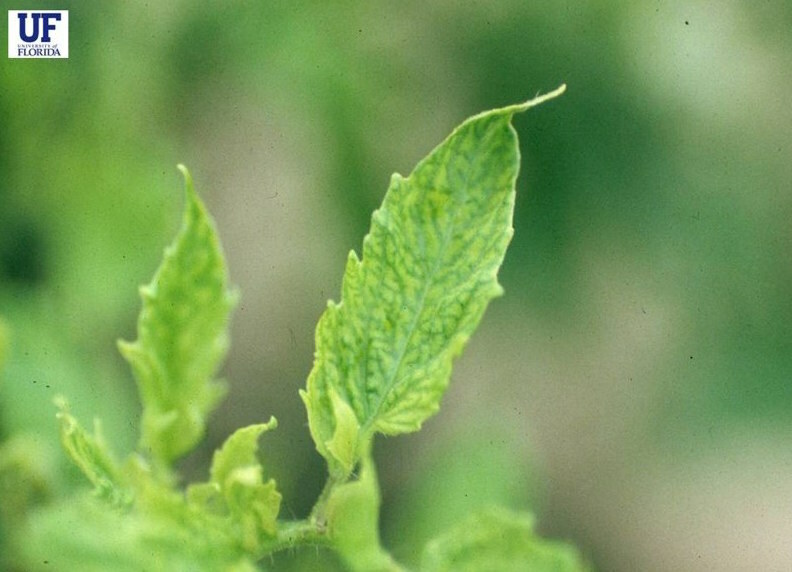
Little leaf symptoms
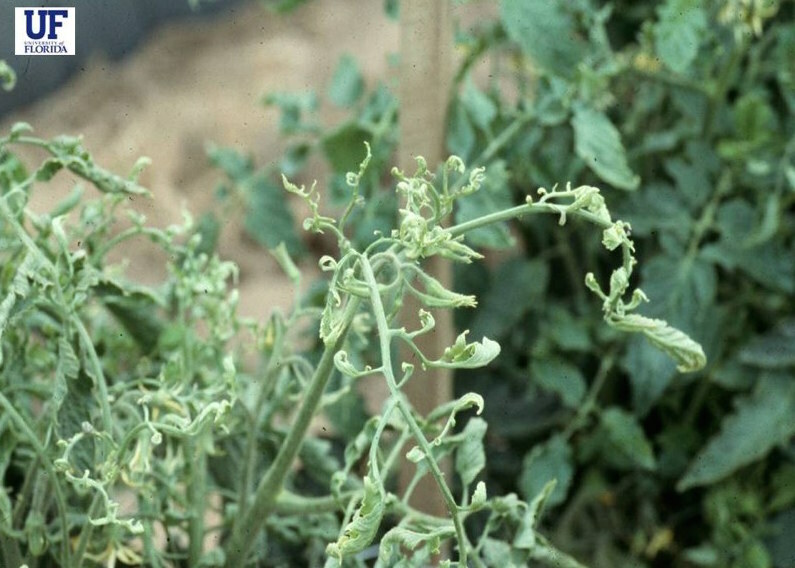
Little leaf symptoms

Interveinal chlorosis
Symptoms
Little leaf symptoms include interveinal chlorosis of young leaves, distortion and failure of leaves along the midrib to expand, radial cracks of fruits extending from the calyx to the blossom scar and failure of blooms to set; symptoms progress to increased leaflet distortion and more pronounced interveinal chlorosis.
Cause
Physiological disorder
Comments
Management
Little leaf is usually associated with water-logged areas of fields, subsequent drying out of affected areas usually resolves the problem and subsequent plant growth is normal; controlling the soil pH may also help the problem.
Magnesium deficiency

Magnesium deficiency
Symptoms
Symptoms of magnesium deficiency appear on older leaves first; initial symptoms are interveinal chlorosis of the leaves and, occasionally, a purple tinge to the leaves; as the deficiency becomes more severe, leaves may appear white with green veins; severe deficiencies may lead to reduced fruit yield.
Cause
Nutritional disorder
Comments
Management
Magnesium deficiency can be prevented in tomato by applying dolomite lime to the soil, if an increase in soil pH is required, or through applications of a fertilizer containing magnesium.
Multiple nutrients deficiency
Symptoms
Cause
Nutritional disorder
Comments
Nitrogen deficiency
Symptoms
Affected plants are smaller in size and grow less vigorously than healthy plants; symptoms appear on older leaves first; tomato leaves exhibit a general yellowing occasionally accompanied by purple leaf veins; plants possess thinner stems and fruit is smaller than healthy plants; fruits may be misshapen with a lighter red color than healthy plants.
Cause
Nutritional disorder
Comments
Management
If detected early, symptoms of nitrogen deficiency can be treated by applying appropriate amounts of nitrogen fertilizer.
Phosphorous deficiency
Symptoms
Growth of tomato seedlings is reduced compared with healthy plants; leaves appear darker green and may have a purple tinge; in older tomato plants, leaves grow upright and appear light green on the upper surface and purple on the lower surface; symptoms appear on older leaves first.
Cause
Nutritional disorder
Comments
Management
Soil levels of phosphorous should be measured prior to planting to determine the appropriate application for the particular site; phosphorous should be applied to the soil prior to planting if required as applications made after the onset of tomato growth are not usually successful in preventing symptoms.
Potassium deficiency
Symptoms
Affected plants are smaller than healhty plants with smaller fruits and reduced yields; tomato leaves exhibit "bronzing", older plant leaves turn tan and then brown at the margins; if deficiency is prolonged, leaves become necrotic at the margins and turn yellow between leaf veins.
Cause
Nutritional disorder
Comments
Management
Potassium deficiency can be corrected through applications of the nutrient as a side dressing and/or through an irrigation system.
Sunscald
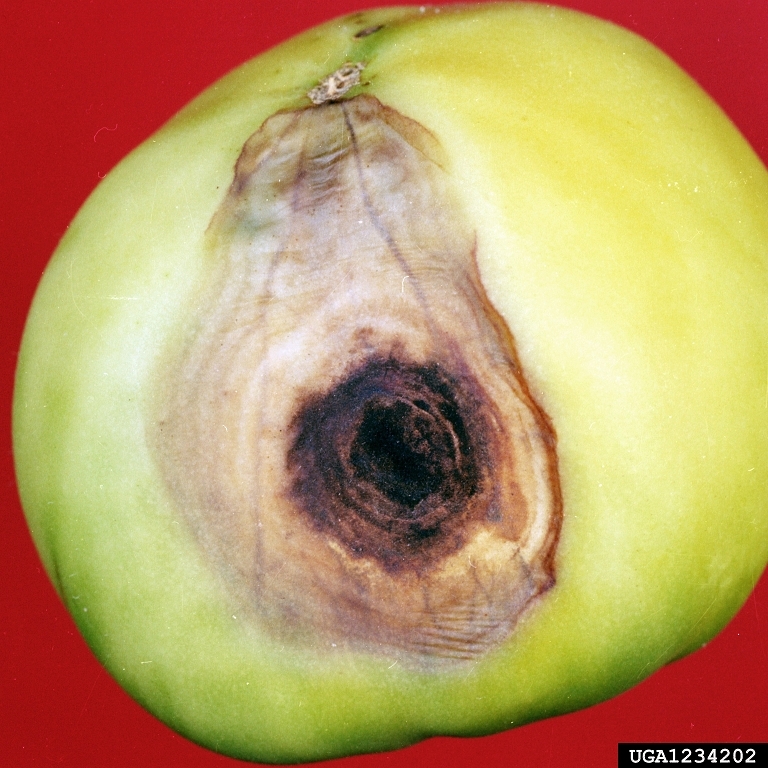
sunscald affected fruit

Sunscald on tomato

Sunscald
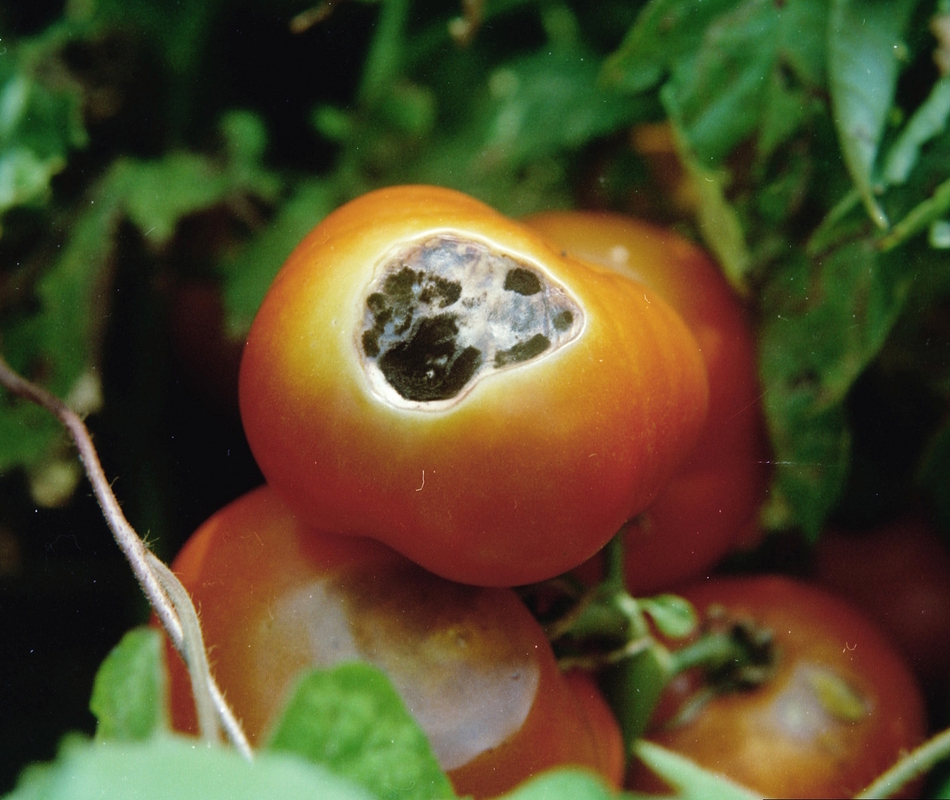
Sunscald on tomato
Symptoms
Symptoms of sunscald are most common on green fruit; white or yellow necrotic patches develop on the sides of the fruit that are facing the sun; blisters may be white with a yellow halo; damaged areas may become flattened in appearance and papery in texture; damaged areas are often invaded by secondary pathogens and turn black.
Cause
Physiological disorder
Comments
Management
Healthy plants with full foliage are less susceptible to sunscald as the leaves provide fruits with shading, ensure plants are watered regularly and fertilized adequately; use shade cloth to protect the fruits from the sun; control diseases that develop to prevent defoliation which can lead to sunscald.
Water stress

Moisture stress rings (from fluxuations in water, most likely because of heavy rains)

Water stress cracks on tomato fruits
Symptoms
Leaves are green but wilting; leaves roll downwards and eventually drop from the plant; fruits may develop symptoms of Blossom-end rot (See entry).
Cause
Physiological stress
Comments
Management
Tomato plants should be watered deeply and evenly to avoid water stress; aim to keep the soil moist but not wet; allow the top of the soil to dry before watering again.
Zippering
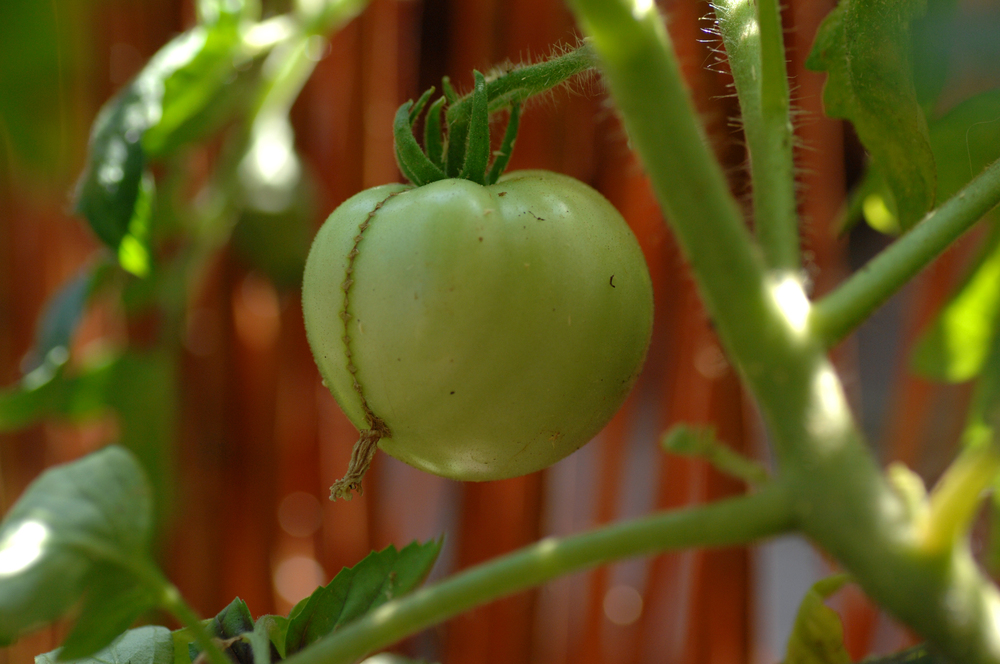
Zippering

Zippering of tomato
Symptoms
Thin brown scars extending longutudinally from the petiole to the blossom-end of the fruit; each scar has smaller scars crossing it tranversely rendering it zipper-like in appearance; holes may open on along the scarred area.
Cause
Physiological disorder
Comments
Management
The most effective method of preventing zippering is to grow tolerant varieties; when growing tomatoes in the glasshouse, appropriate temperatures should be maintained.
Category : Oomycete
Buckeye rot (Phytophthora root rot)
Phytophthora spp.
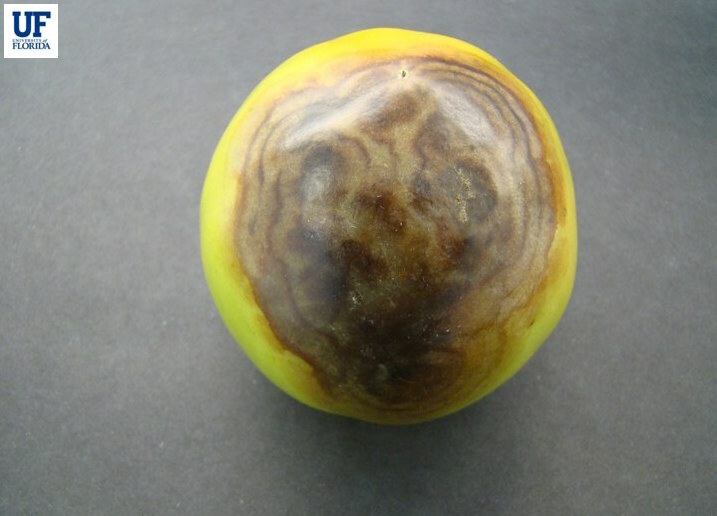
Buck eye symptoms on green fruit

Root rot infection on young plants

Symptoms of buckeye rot on tomato fruit

Buck eye symptoms on green fruit

Tomato fruits infected with buckeye rot

Symptoms of buckeye rot on tomato fruit

Completely wilted plants due to Phytophthora root rot

Tomato fruits infected with buckeye rot
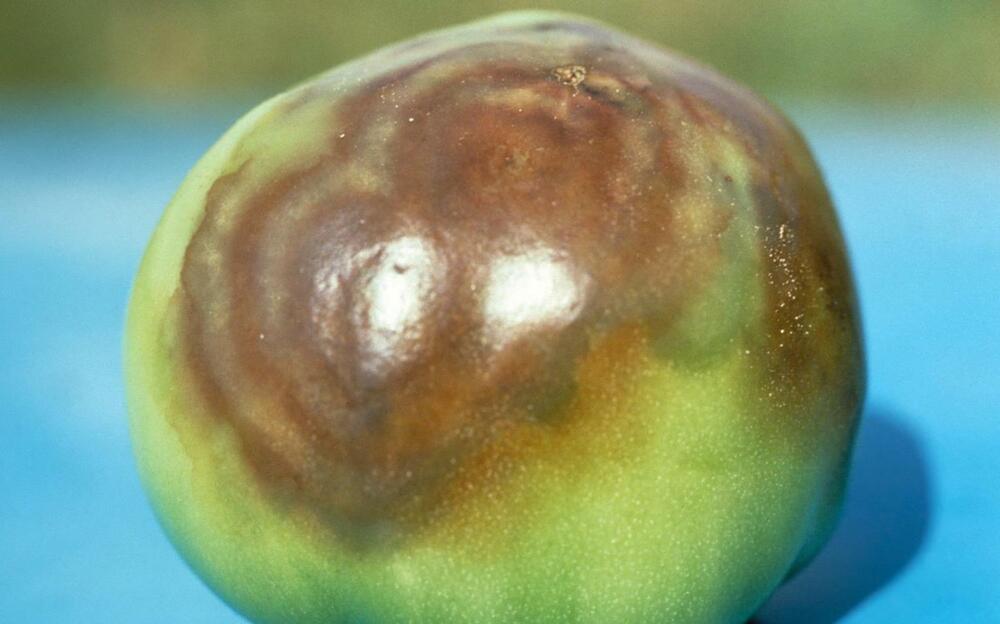
Symptoms of buckeye rot on tomato fruit
Symptoms
Buck eye rot of tomato initially appears as a brown spot on the fruit which enlarges over the fruit surface and forms concentric rings; the lesions may eventually cover up to half of the fruit and the flesh develops a soft rot underneath the skin; green or red fruits can be affected and disease often develops where fruit is in contact with the soil; white cottony growth may be visible in the centers of affected regions; spots enlarge and form large concentric ring shaped symptoms which are usually brown in color with sunken edges; the Phytophthora pathogen also causes root rot; young plants may exhibit a white cottony growth at crown of the plant and begin to wilt as the damage to the roots progresses; Phytophthora root rot can cause severe destruction of plant roots and cause the plants to wilt completely.
Cause
Fungi
Comments
Management
Cultural control methods such as mulching around the plants and practicing rotation away from tomato can help to reduce losses from the disease; fungicides applied for the control of late blight also help to control the development of buckeye rot; solarizing or fumigating soil can help to reduce levels of inoculum.
Late blight
Phytophthora infestans

The entire fruit can become infected, and the white mycelium may appear during wet weather

Fruit lesions start as water soaked regions

Late blight symptoms on tomato stem

Late blight symptoms on tomato leaves

Late blight stem lesion

Late blight symptoms on tomato

Late blight symptoms on tomato
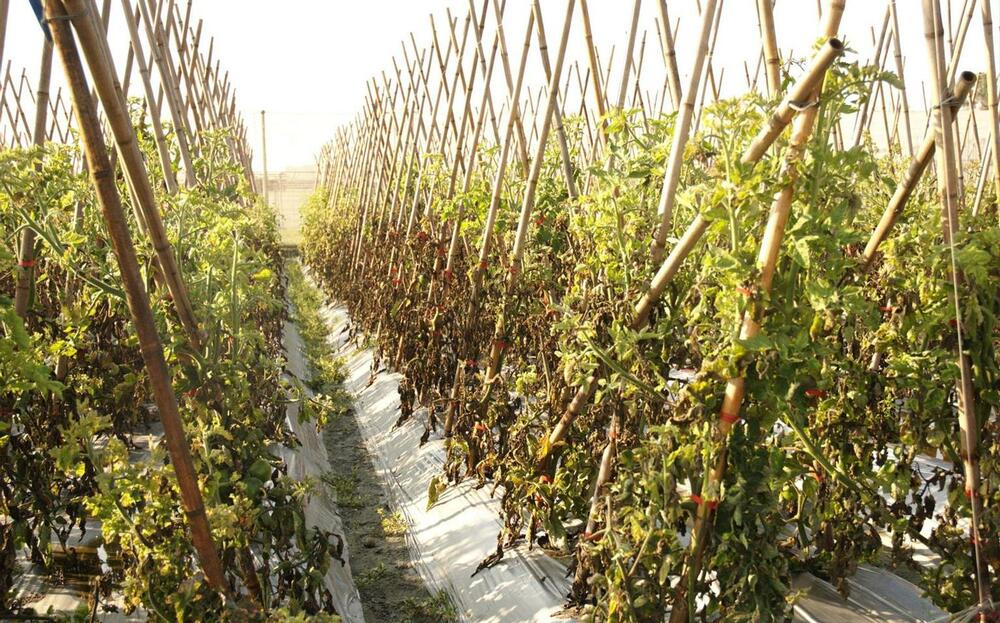
Tomato plantation with late blight infestation

Late blight symptoms on tomato foliage
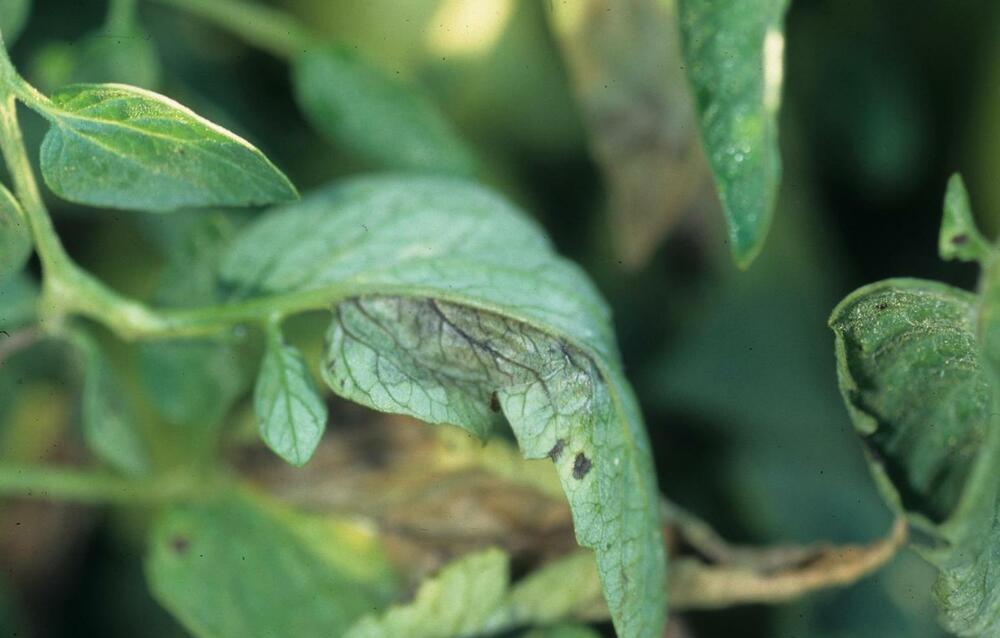
Late blight symptoms on tomato foliage

Fruit lesions changes to greasy spots
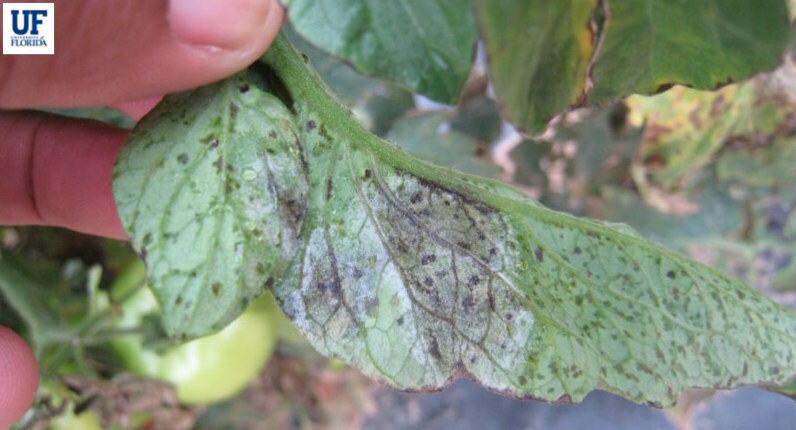
White moldy growth on the underside of the leaves
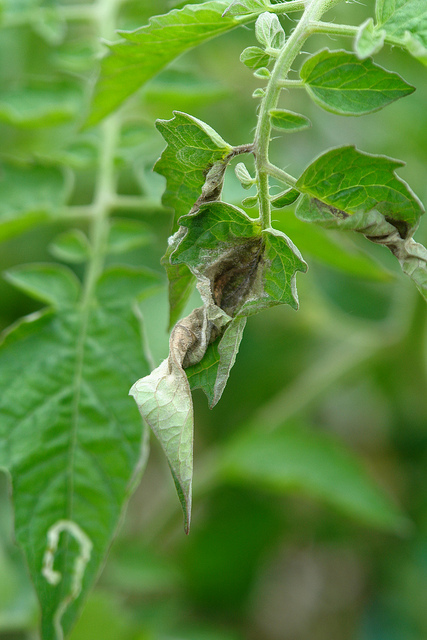
Late blight symptoms on tomato leaves

Late blight symptoms on tomato stem
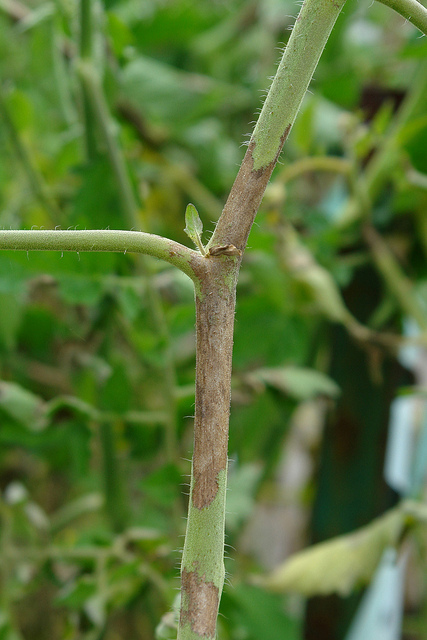
Late blight symptoms on tomato stem

Late blight symptoms on tomato
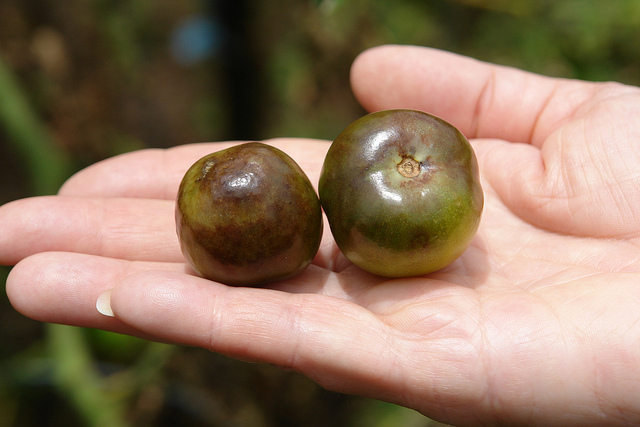
Late blight symptoms on tomato fruit

Late blight lesion on tomato leaf

Late blight symptoms on tomato fruit

Late blight symptoms on tomato fruit

Foliage becomes shriveled and brown
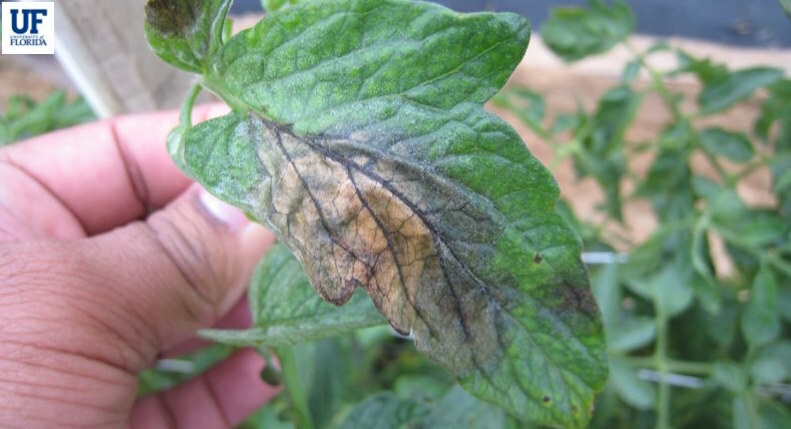
Leaf lesions appear as water-soaked regions that rapidly change to brown lesions

Late blight symptoms on tomato

Late blight symptoms on tomato stems
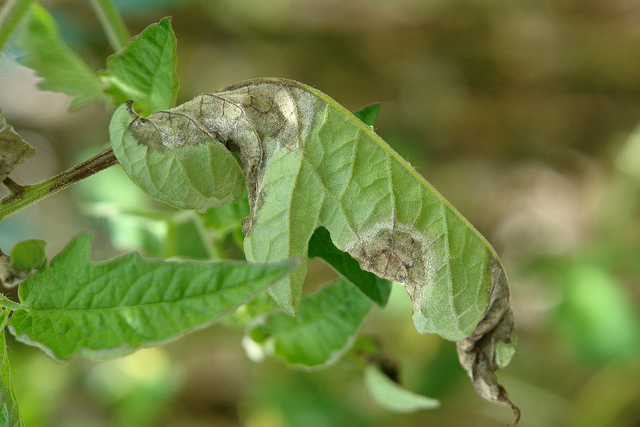
Late blight symptoms on tomato foliage

Late blight symptoms on tomato

Late blight symptoms on tomato
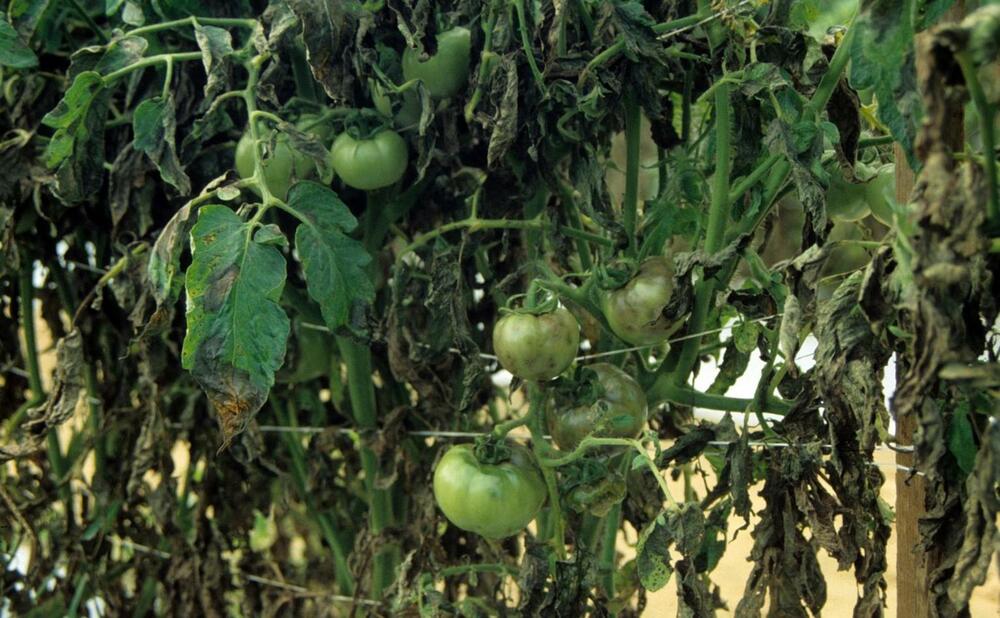
Tomato plants damaged by late blight

Late blight symptoms on tomato fruit

Late blight symptoms on tomato foliage
Symptoms
Late blight affects all aerial parts of the tomato plant; initial symptoms of the disease appear as water-soaked green to black areas on leaves which rapidly change to brown lesions; fluffy white fungal growth may appear on infected areas and leaf undersides during wet weather; as the disease progresses, foliage becomes becomes shriveled and brown and the entire plant may die; fruit lesions start as irregularly shaped water soaked regions and change to greasy spots; entire fruit may become infected and a white fuzzy growth may appear during wet weather.
Cause
Oomycete
Comments
Management
Plant resistant varieties; if signs of disease are present or if rainy conditions are likely or if using overhead irrigation appropriate fungicides should be applied.
Category : Viral
Tomato mosaic virus
Tomato mosaic virus (ToMV)
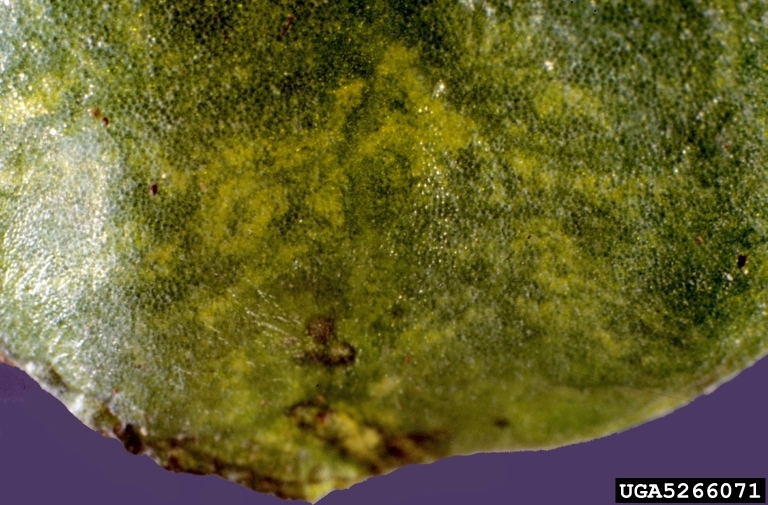
Symptoms on leaves

Tomato Mosaic Virus (Tobamovirus ToMV) infected tomato plant

Tomato Mosaic Virus symptom on tomato plant
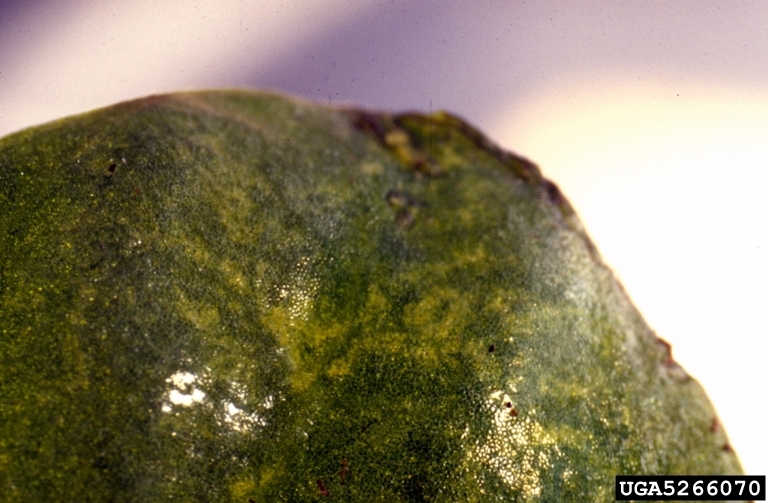
ToMV infected tomato leaf
Symptoms
Symptoms can occur at any growth stage and any part of the plant can be affected; infected leaves generally exhibit a dark green mottling or mosaic; some strains of the virus can cause yellow mottling on the leaves; young leaves may be stunted or distorted; severely infected leaves may have raised green areas; fruit yields are reduced in infected plants; green fruit may have yellow blotches or necrotic spots; dark necrotic streaks may appear on the stems, petioles leaves and fruit.
Cause
Virus
Comments
Management
Plant varieties that are resistant to the virus; heat treating seeds at 70°C (158°F) for 4 days or at 82–85°C (179.6–185°F) for 24 hours will help to eliminate any virus particles on the surface of the seeds; soaking seed for 15 min in 100 g/l of tri-sodium phosphate solution (TSP) can also eliminate virus particles - seeds should be rinsed thoroughly and laid out to dry after this treatment; if the virus is confirmed in the field, infected plants should be removed and destroyed to limit further spread; plant tomato on a 2-year rotation, avoiding susceptible crops such as peppers, eggplant, cucurbits and tobacco; disinfect all equipment when moving from infected areas of the field.
Tomato spotted wilt
Tomato spotted wilt virus (TSWV)

Severe stunting of the plants can also be seen in case of TSWV infection

Leaf purpling can vary in its form for different varieties

Numerous small ring spots on a fruit infected with TSWV.

Severe leaf spot symptoms can be seen
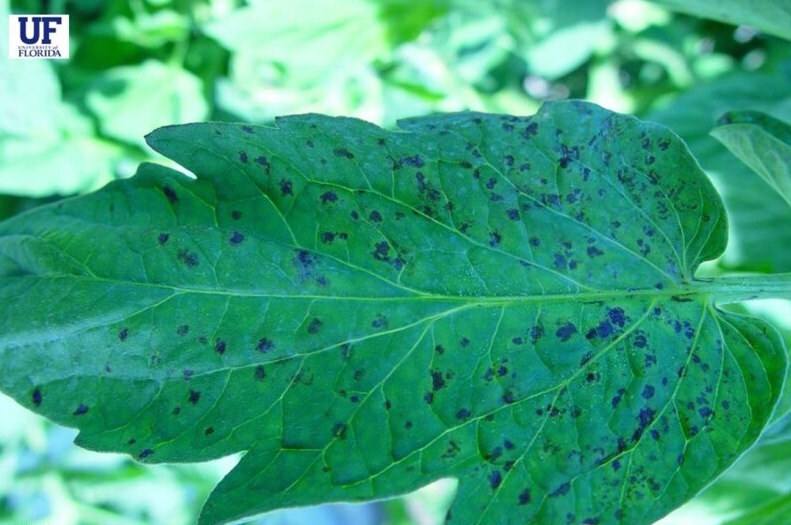
Leaf spots may resemble bacterial spot

Symptoms of TSWV on tomato foliage

Symptoms of TSWV on tomato fruit

TSWV symptoms on tomato fruit
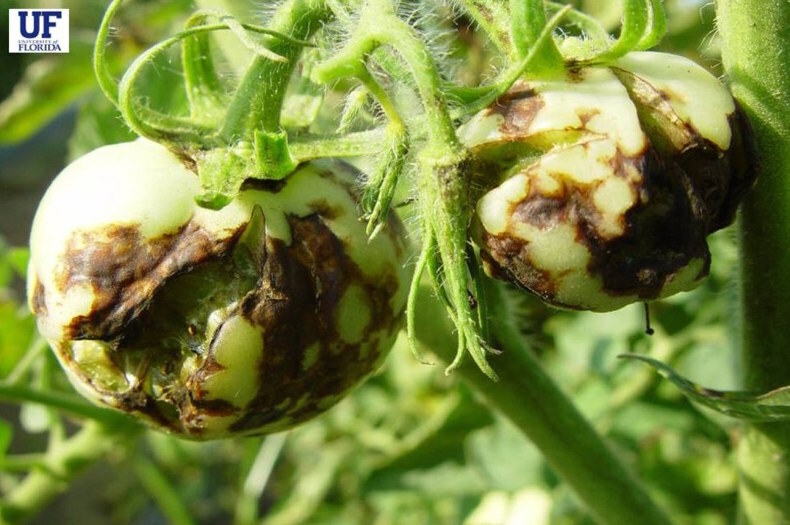
Fruit necrosis and splitting

Zonate ring spots on a fruit infected with TSWV.

Large ring spot symptoms

Large necrotic areas may form on the leaves

Symptoms of TSWV
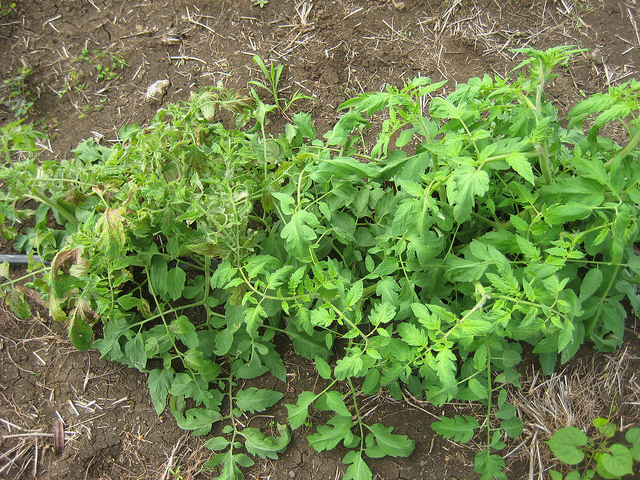
Symptoms of TSWV on tomato foliage
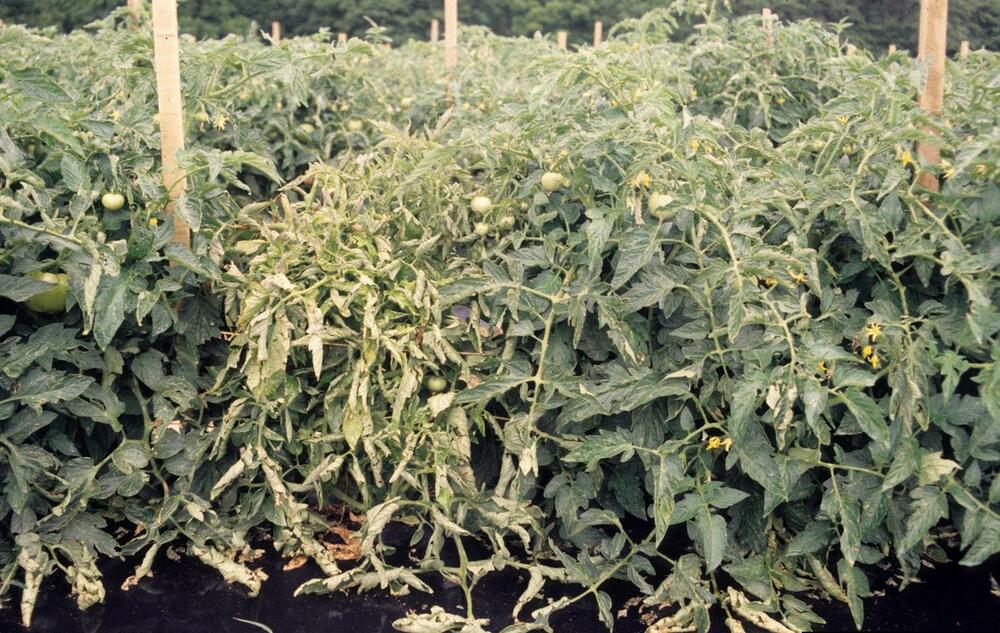
Tomato plants infected with TSWV
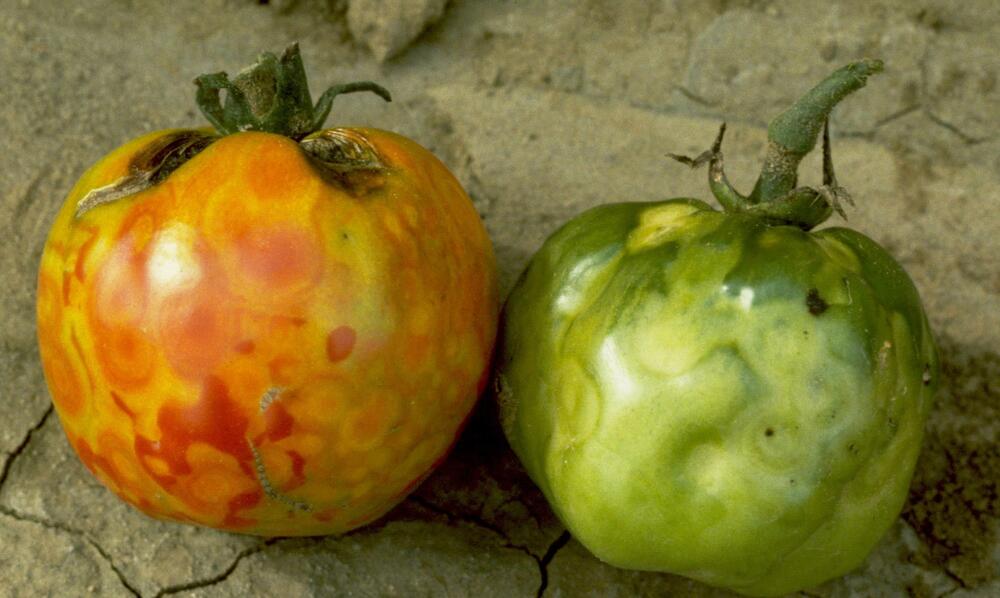
TSWV symptoms on tomato fruit
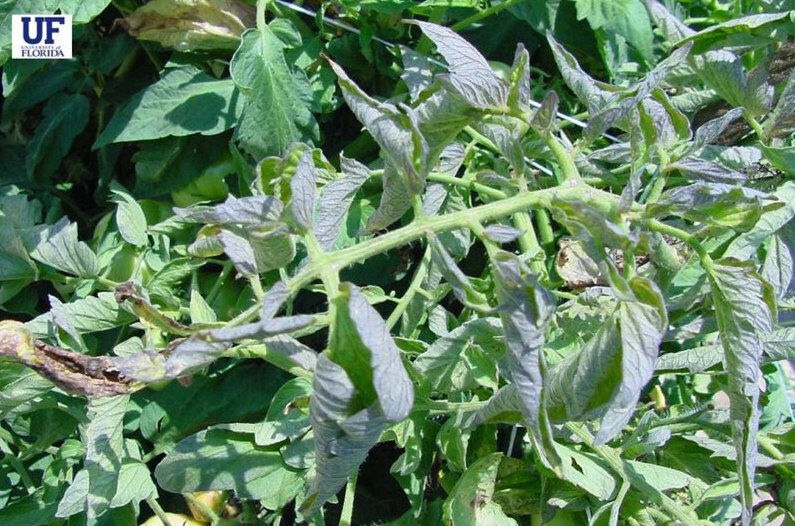
Leaf purpling is another symptom of plants infected with TSWV.

Complex ring spots on fruit infected with TSWV

Fruit symptoms on a mature green fruit

Leaf symptoms
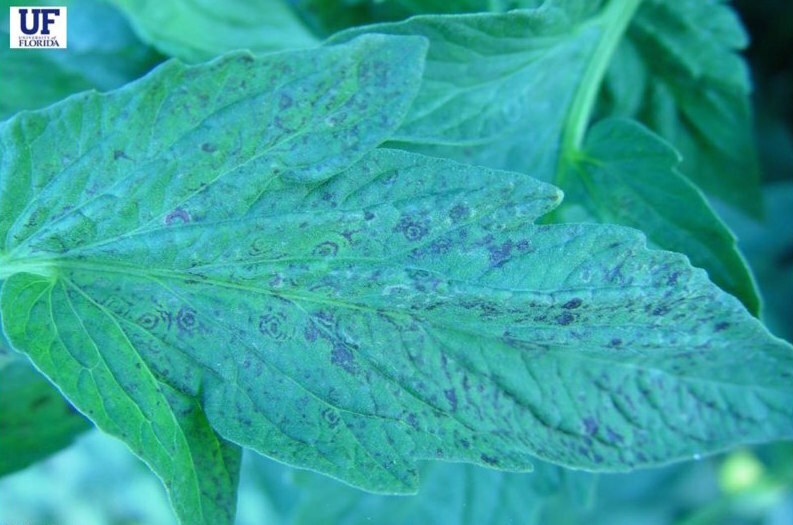
Symptoms of TSWV vary among different varieties of tomato

Necrotic spots on tomato leaf caused by TSWV
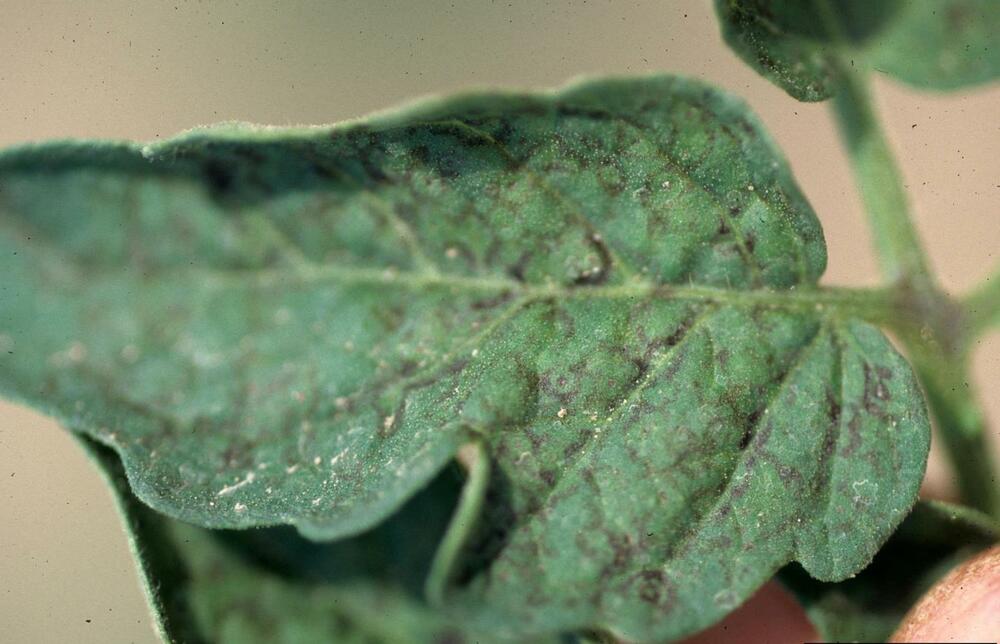
TSWV symptoms on tomato leaf
Symptoms
Infected plants exhibit bronzing or purpling of the upper sides of young leaves and develop necrotic spots; leaf spots may resemble those caused by bacterial spot, but a bacterial ooze test will be negative; leaves may cup downwards, shoot tips may begin to die back; symptoms on ripe fruit appear as chlorotic spots and blotches, often with concentric rings; ring spot symptoms vary with different tomato cultivars; irregular ripening caused by TSWV can also show up when fruit are treated with ethylene gas; green fruit may exhibit slightly raised areas with faint concentric zonation.
Cause
Virus
Comments
Management
Control populations of western flower thrips and onion thrips
Tomato Yellow Leaf Curl disease
Tomato Yellow Leaf Curl Virus (TYLCV)
family Geminiviridae, genus Begomovirus

Early infection of tomato by tomato yellow leaf curl virus often leads to severe stunting of the plant. Infected plant in the foreground with an uninfected one in the back.

Symptoms on infected tomato plant

Infection at later stages of the plant often leads to stunting and malformation of terminals, yellowing of leaf margins and the characteristics upward cupping of leaves ("leaf curl")

Symptoms of TYLCV on greenhouse-grown tomatoes.

Tomato Leaf Curl Virus symptoms
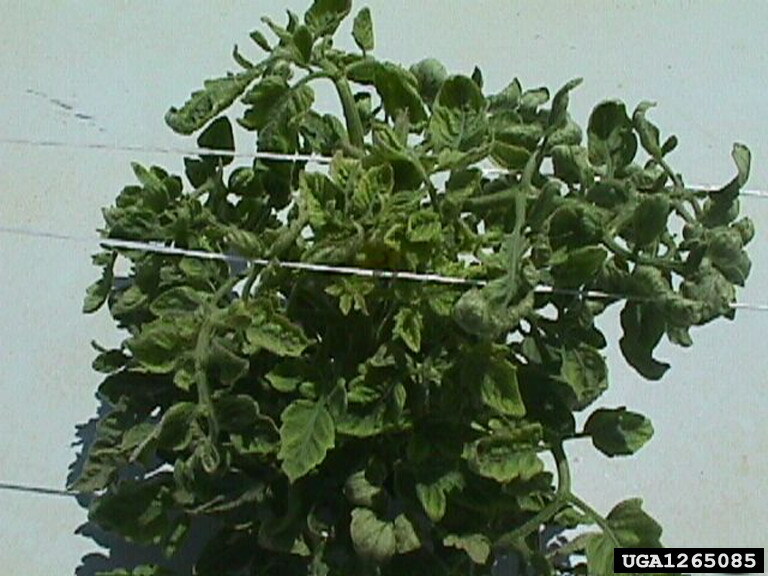
TYLCV infected plant

Symptoms on leaves

Yellowing and shortening of internodes of greenhouse-grown tomatoes due to TYLCV.

Tomato plant affected by Tomato Leaf Curl Virus.

TYLCV infected field

TYLCV infected leaves
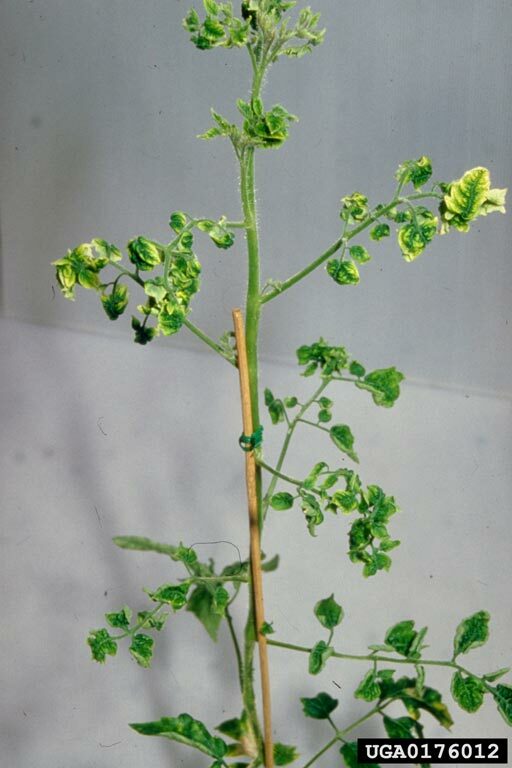
Tomato Yellow Leaf Curl Virus (Begomovirus TYLCV) infected plant
Symptoms
The infected leaves become reduced in size, curl upward, appear crumpled and show yellowing of veins and leaf margins. The internodes become shorter and whole plant appear stunted and bushy. The whole plant stand erect with only upright growth. The flowers may not develop and drop off.
Cause
Virus
Comments
Management
Grow available resistant varieties. Transplant only disease and whiteflies free seedlings. Remove the infected plants and burn them. Keep the field free from weeds. Use yellow sticky traps to monitor and control whiteflies. If the insect infestation is severe spray suitable insecticides.
Pests
Category : Insects
Aphids (Peach aphid, Potato aphid)
Myzus persicae
Macrosiphon euphorbiae

Potato aphids feeding on tomato leaf

Green peach aphid adult

Green peach aphid (Myzus persicae) nymphs

Potato aphid on tomato leaf

Potato aphid (Macrosiphum euphorbiae) on tomato leaves

Aphids feeding on tomato (note presence of 'mummies' - parasitized aphids)

Potato aphids adult

Green peach aphid (Myzus persicae) adults
Symptoms
Small soft bodied insects on underside of leaves and/or stems of plant; usually green or yellow in color, but may be pink, brown, red or black depending on species and host plant; if aphid infestation is heavy it may cause leaves to yellow and/or be distorted, necrotic spots on leaves and/or stunted shoots; aphids secrete a sticky, sugary substance called honeydew which encourages the growth of sooty mold on the plants.
Cause
Insect
Comments
Management
If aphid population is limited to just a few leaves or shoots then the infestation can be pruned out to provide control; check transplants for aphids before planting; use tolerant varieties if available; reflective mulches such as silver colored plastic can deter aphids from feeding on plants; sturdy plants can be sprayed with a strong jet of water to knock aphids from leaves; insecticides are generally only required to treat aphids if the infestation is very high - plants generally tolerate low and medium level infestation; insecticidal soaps or oils such as neem or canola oil are usually the best method of control; always check the labels of the products for specific usage guidelines prior to use.
Beet armyworm
Spodoptera exigua

Beet armyworm eggs covered in white hairs

Young larvae

Beet armyworm larva
Symptoms
Singular, or closely grouped circular to irregularly shaped holes in foliage; heavy feeding by young larvae leads to skeletonized leaves; shallow, dry wounds on fruit; egg clusters of 50-150 eggs may be present on the leaves; egg clusters are covered in a whitish scale which gives the cluster a cottony or fuzzy appearance; young larvae are pale green to yellow in color while older larvae are generally darker green with a dark and light line running along the side of their body and a pink or yellow underside.
Cause
Insect
Comments
Management
Organic methods of controlling the beet armyworm include biological control by natural enemies which parasitize the larvae and the application of Bacillus thuringiensis; there are chemicals available for commercial control but many that are available for the home garden do not provide adequate control of the larvae.
Colorado potato beetle
Leptinotarsa decemlineata

Adult beetles on Jimsonweed

Larva

Colorado potato beetle larvae on tomato leaf
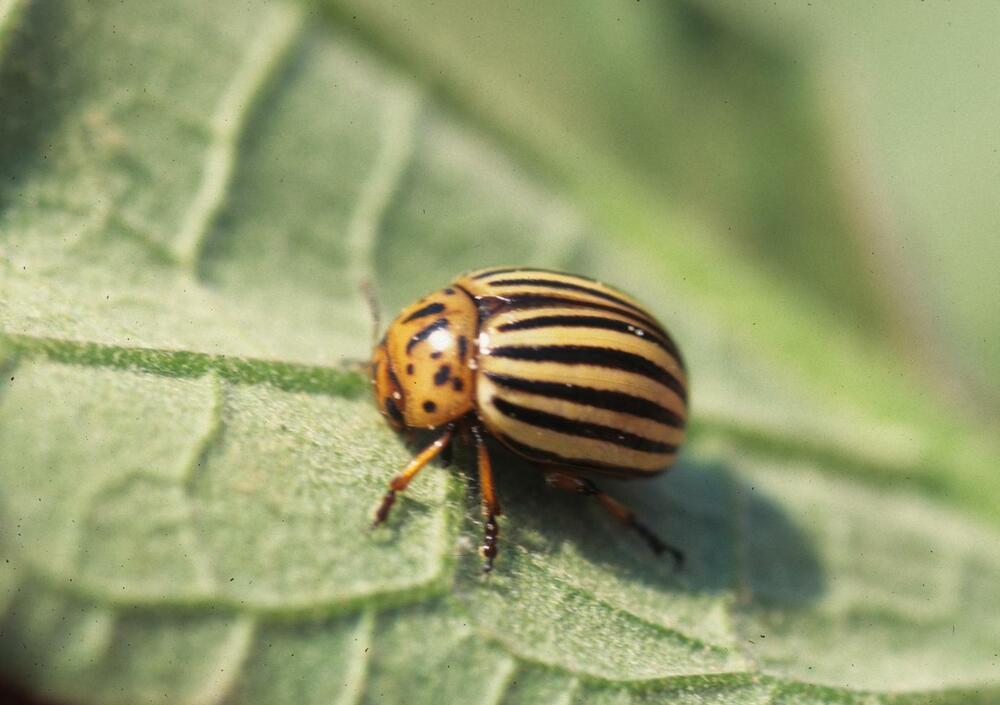
Adult beetle
Symptoms
Feeding damage to foliage; if infestation is severe or if left untreated plants can be completely defoliated; adult insect is a black and yellow striped beetle; larvae are bright red with black heads when they first hatch and change color to pink; larvae have two rows of black spots.
Cause
Insect
Comments
Management
Control of Colorado potato beetle can be challenging as they have developed high levels of insecticide resistance; adults and larvae should be hand picked from plants and destroyed in soapy water; applications of Bacillus thuringiensis can be effective at controlling larvae but should be applied frequently; some insecticides, including spinosad, are still effective against adult beetles.
Cutworms
Various species including:
Agrotis spp.
Peridroma saucia
Nephelodes minians
etc.

Cutworm feeding on plant stem

Cutworms will curl up into a characteristic C shape when disturbed
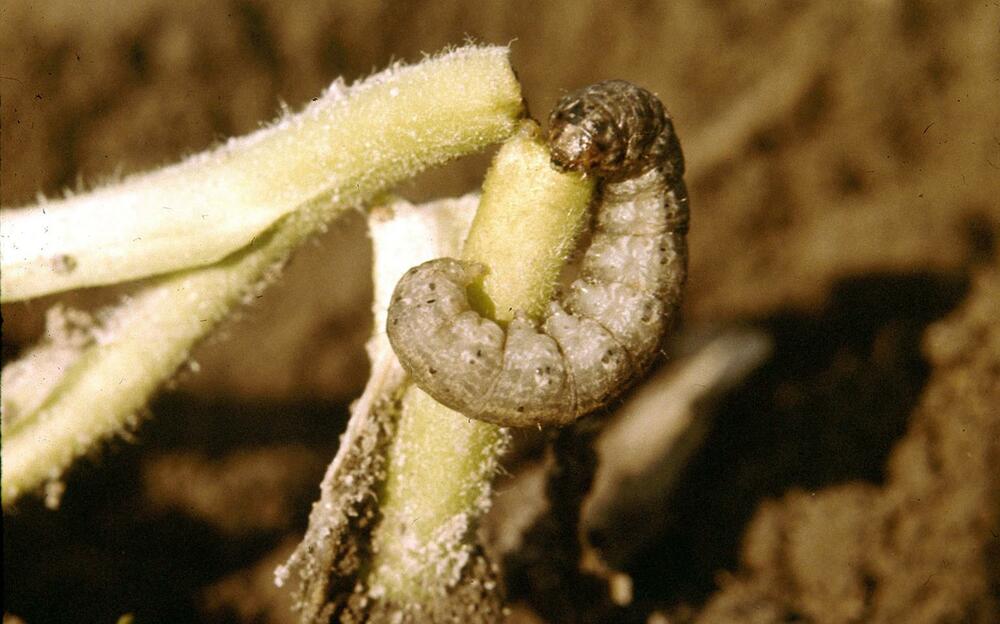
Cutworms larva severing plant stem
Symptoms
Stems of young transplants or seedlings may be severed at soil line; if infection occurs later, irregular holes are eaten into the surface of fruits; larvae causing the damage are usually active at night and hide during the day in the soil at the base of the plants or in plant debris of toppled plant; larvae are 2.5–5.0 cm (1–2 in) in length; larvae may exhibit a variety of patterns and coloration but are usually dirty gray or brown to black with dark spots or lines and will curl up into a characteristic C-shape when disturbed
Cause
Insect
Comments
Management
Remove all plant residue from soil after harvest or at least two weeks before planting, this is especially important if the previous crop was another host such as alfalfa, beans or a leguminous cover crop; plastic or foil collars fitted around plant stems to cover the bottom 3 inches above the soil line and extending a couple of inches into the soil can prevent larvae severing plants; hand-pick larvae after dark; spread diatomaceous earth around the base of the plants (this creates a sharp barrier that will cut the insects if they try and crawl over it); apply appropriate insecticides to infested areas of garden or field if not growing organically
Flea beetles
Epitrix spp.

Potato flea beetle injury on potato leaf
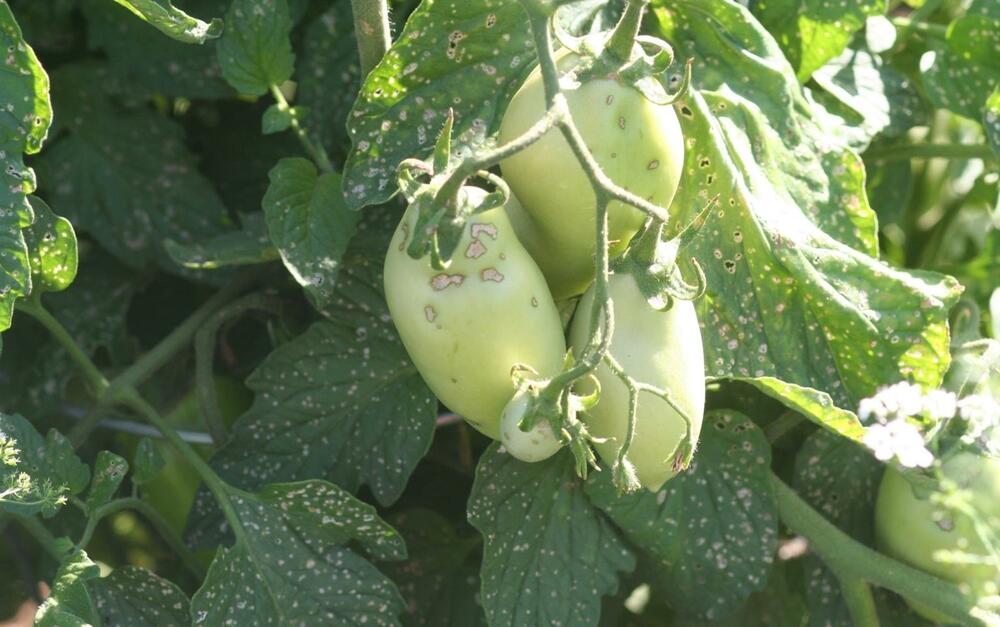
Flea beetle damage to tomato leaves and fruit

Typical shothole feeding wounds of potato flea beetles on tomato leaf
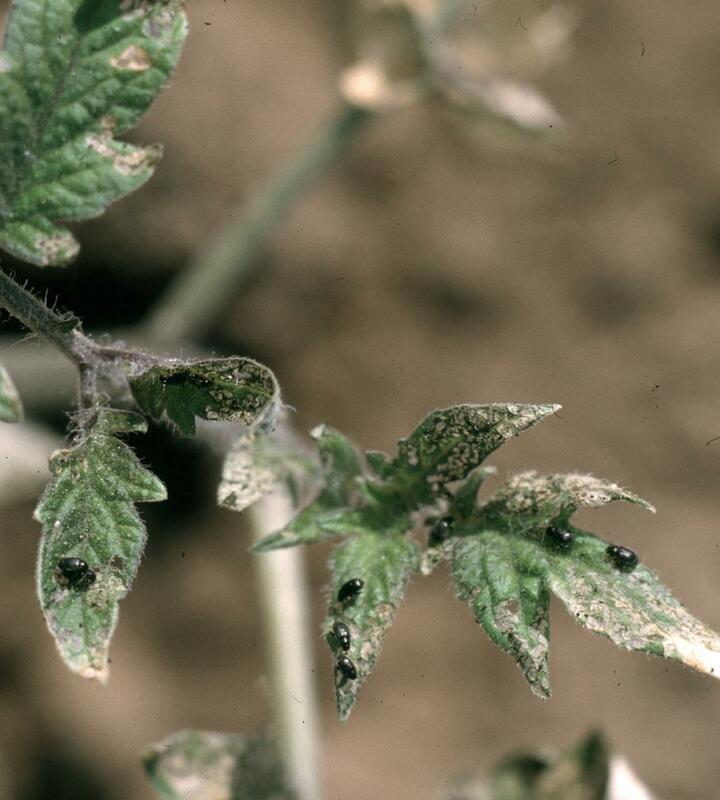
Flea beetles causing damage to a young tomato seedling

Feeding damage to tomato fruit
Symptoms
Small holes or pits in leaves that give the foliage a characteristic “shothole” appearance; young plants and seedlings are particularly susceptible; plant growth may be reduced; if damage is severe the plant may be killed; feeding damage may also occur on the fruit; the pest responsible for the damage is a small (1.5–3.0 mm) dark colored beetle which jumps when disturbed; the beetles are often shiny in appearance.
Cause
Insects
Comments
Management
In areas where flea beetles are a problem, floating row covers may have to be used prior to the emergence of the beetles to provide a physical barrier to protect young plants; plant seeds early to allow establishment before the beetles become a problem - mature plants are less susceptible to damage; trap crops may provide a measure of control - cruciferous plants are best; application of a thick layer of mulch may help prevent beetles reaching surface; application on diamotecoeus earth or oils such as neem oil are effective control methods for organic growers; application of insecticides containing carbaryl, spinosad, bifenthrin and permethrin can provide adequate control of beetles for up to a week but will need reapplied.
Hornworms (Tomato hornworm, Tobacco hornworm)
Manduca quinquemaculata
Manduca sexta

Tomato hornworm frass

Tobacco hornworm

Tomato hornworm (Manduca quinquemaculata) on tomato
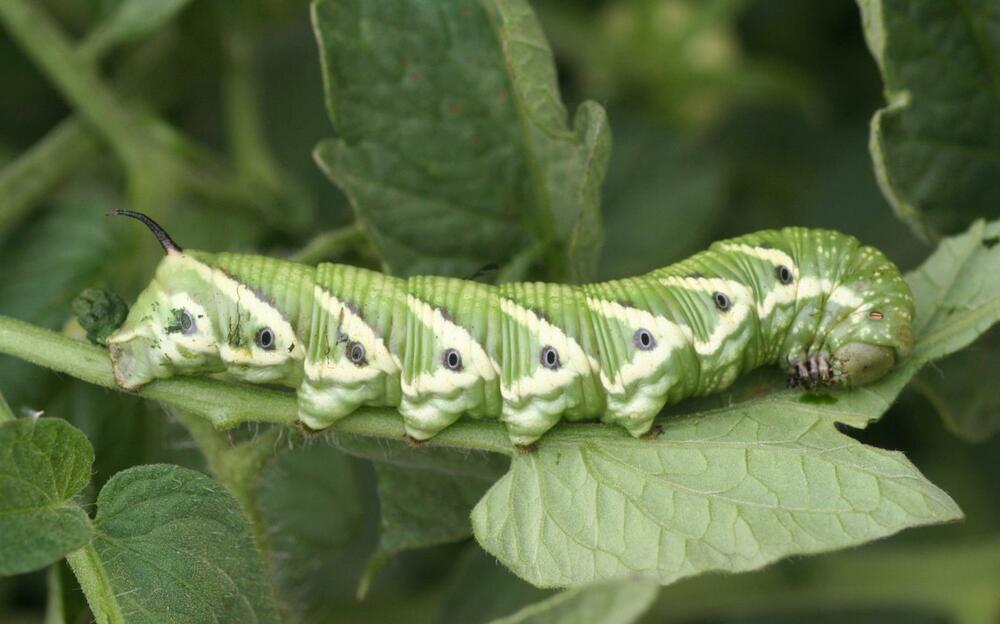
Tomato hornworm (note black spike on posterior)

Tobacco hornworm (Manduca sexta) on tomato vine

Parasitized tobacco hornworm with wasp cocoons on its back
Symptoms
Feeding damage to leaves or leaves stripped from plant; heavy infestation may result in damage to fruit appearing as large open scars; large green caterpillars may be spotted on plant; caterpillars may reach in excess of 7.5 cm (3 in) in length and possess a spike at the end of their body; most common species have 7 diagonal stripes on sides or 8 v-shaped markings on each side; single eggs may be present on leaves and measure approx 1.3 mm in diameter; eggs are in initially light green in color and turn white prior to hatching.
Cause
Insect
Comments
Management
Hand pick larvae from plants leaving any parasitized larvae behind to promote populations of natural enemies (these larvae can be distinguished by the presence of white, oblong-shaped cocoons on their backs); sprays of Bacillus thuringiensis are organically acceptable and highly effective.
Leafminers
Tuta absoluta
Lyriomyza spp.

Water synthetic sex pheromones trap for Tuta absoluta

Tuta absoluta adult insect

Leafminer damage on tomato plant

Leafminer injury to tomato leaves

Tomato leafminer damage

Leafminer damage on tomato leaf

Leaf miner injured tomato leaves

Leafminer damaged leaves
Symptoms
Thin, white, winding trails on leaves; heavy mining can result in white blotches on leaves and leaves dropping from the plant prematurely; early infestation can cause fruit yield to be reduced; adult leafminer is a small black and yellow moth which lays its eggs in the leaf; larvae hatch and feed on leaf interior. THIS IS A TEST
Cause
Comments
Management
Leafminer natural enemies normally keep populations under control; check transplants for signs of leafminer damage prior to planting; remove plants from soil immediately after harvest if making new plantings in same place or close by; keep the field free from weeds especially Solanum, Datura, Nicotiana; use pheromone traps and white sticky traps to monitor and control insect;only use insecticides when leafminer damage has been identified as unnecessary spraying will also reduce populations of their natural enemies.
Loopers (Cabbage looper , Alfalfa looper)
Trichoplusia ni
Autographa californica

Early install cabbage looper larvae
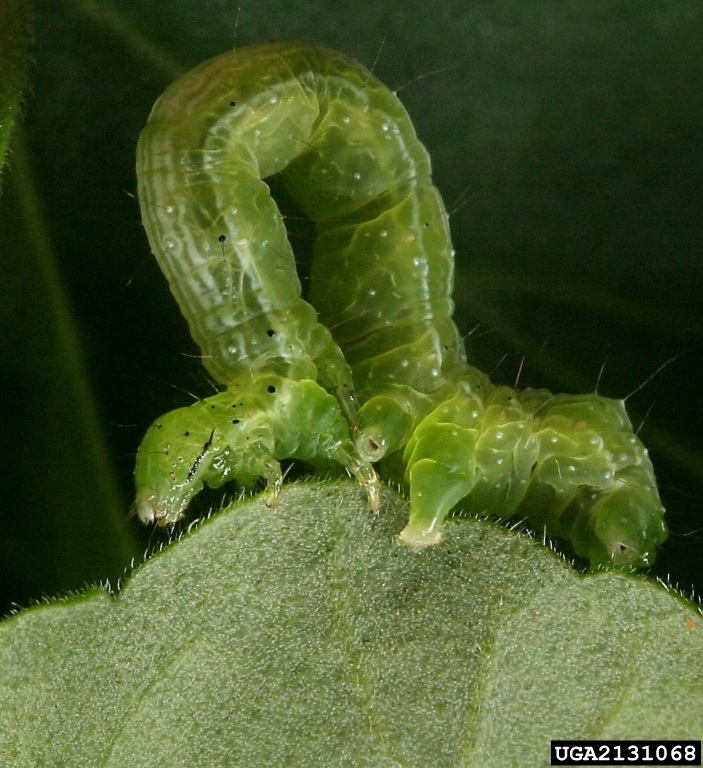
Cabbage looper (Trichoplusia ni)

cabbage looper (Trichoplusia ni) larvae

Cabbage looper (Trichoplusia ni) eggs on tomato leaves

Cabbage looper (Trichoplusia ni) adult
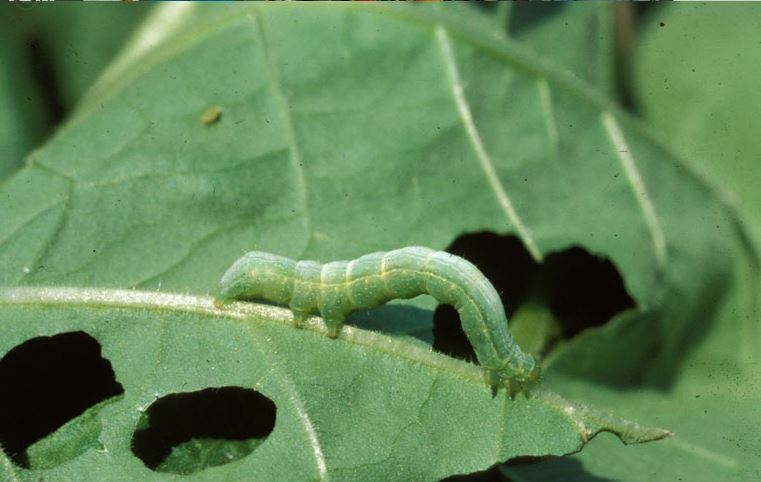
Cabbage looper and damage
Symptoms
Large or small holes in leaves; damage often extensive; caterpillars are pale green with a white lines running down either side of their body; caterpillars are easily distinguished by the way they arch their body when moving; eggs are laid singly, usually on the lower leaf surface close to the leaf margin, and are white or pale green in color.
Cause
Insect
Comments
Management
Looper populations are usually held in check by natural enemies; if they do become problematic larvae can be hand picked from the plants; an organically acceptable control method is the application of Bacillus thuringiensis which effectively kills younger larvae; chemical sprays may also damage populations of natural enemies and should only be considered if sunburn of fruit is likely.
Stinkbugs (Various)
Various

Stink bug feeding on a fruit
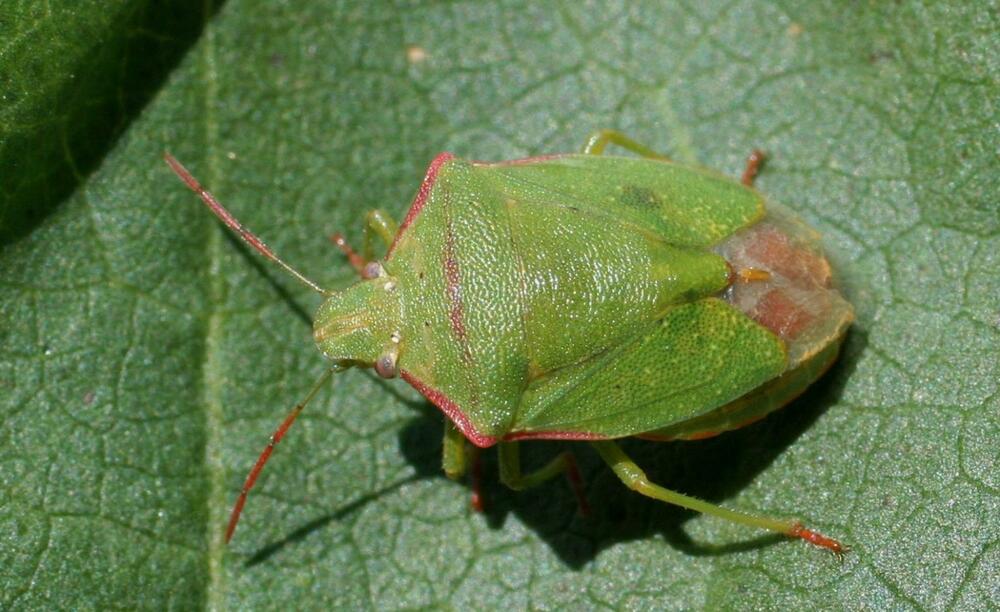
Red shouldered stink bug
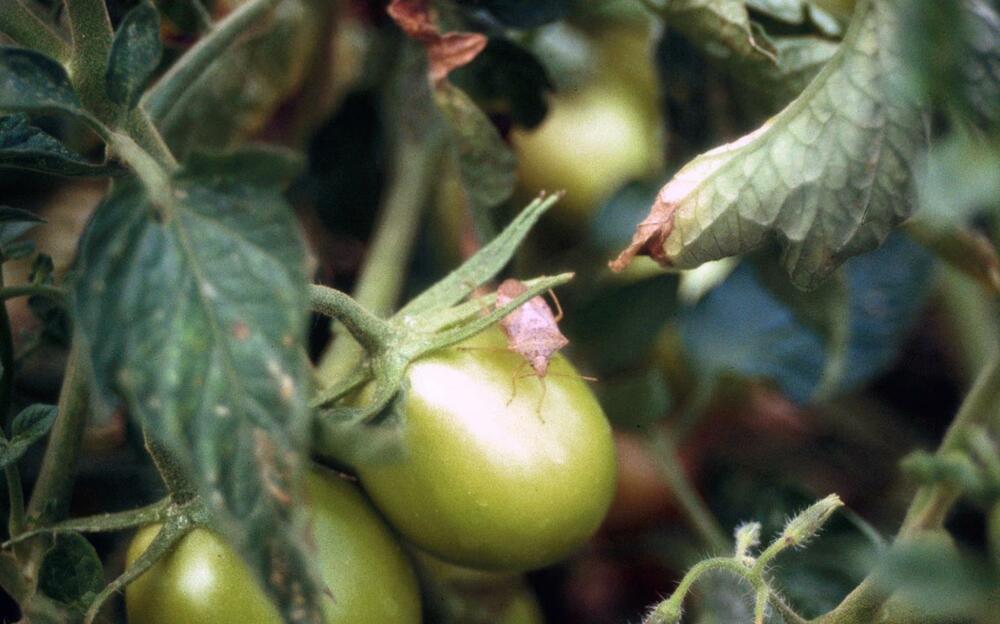
Brown stink bug feeding on tomato fruit

White to yellow spots occurring under the epidermis are a characteristic symptom of cloudy spot caused by stink bug feeding. The symptom is developed due to the release of an enzyme that affects the coloring of a ripening fruit.

Newly hatched brown marmorated stink bug eggs and young larvae

A ripe fruit with a yellow irregular spots
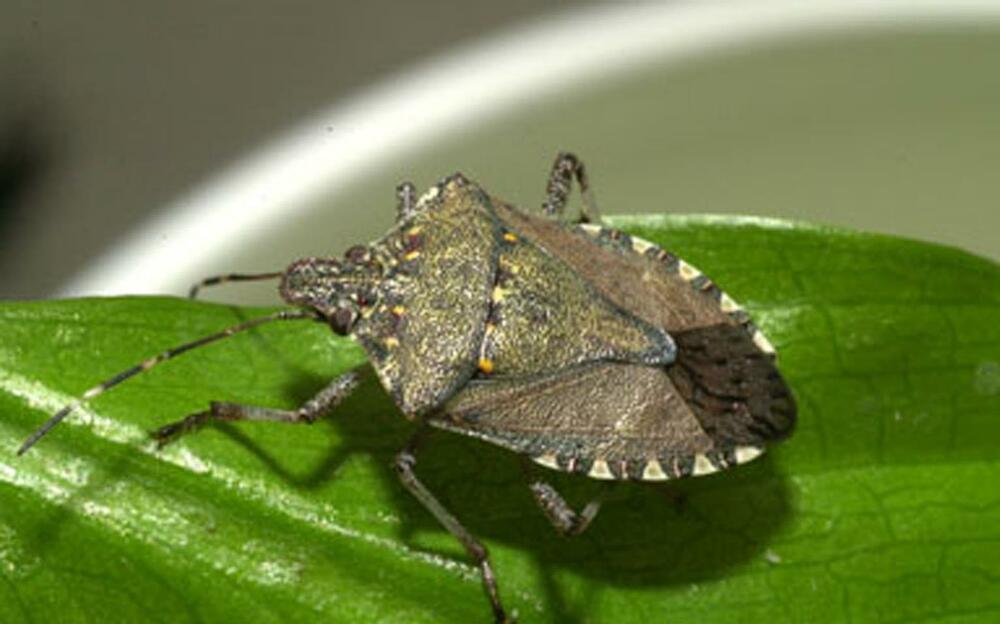
Brown marmorated stink bug
Symptoms
Dark colored pinpricks on fruit surrounded by a lighter area that turns yellow or remains light green; stink bugs often carry pathogens in their mouthparts which can cause secondary infections and decay of fruit; adult insect is shield-shaped and brown or green in color; may have pink, red or yellow markings; eggs are drum shaped and laid in clusters on the leaves; larvae resemble the adults but are smaller.
Cause
Insect
Comments
Management
Remove weeds around crop which may act as overwintering sites for stink bugs and practice good weed management throughout the year; organically accepted control methods include the use of insecticidal soaps, kaolin clay and preservation of natural enemies; chemical treatments are not recommended for tomatoes that are to be processed for paste or canning unless secondary infections with other pathogens are a concern.
Thrips (Western flower thrips, Onion thrips, etc.)
Frankliniella occidentalis
Thrips tabaci

Smaller, tan thrips on left is the onion thrips (Thrips tabaci). Larger yellowish thrips on the right is the western flower thrips (Frankliniella occidentalis).

Green tomato showing damage caused by flower thrips (Frankliniella tritici).

Western flower thrips (Frankliniella occidentalis) damage

Western flower thrips

onion thrips (Thrips tabaci) damage on tomato
Symptoms
If population is high leaves and buds may be distorted; leaves appear silvery and are speckled with black feces; most damage occurs through the transmission of Tomato spotted wilt virus (TSWV); insect is small (1.5 mm) and slender and best viewed using a hand lens; adult thrips are pale yellow to light brown and the nymphs are smaller and lighter in color.
Cause
Insect
Comments
Management
Avoid planting next to onions, garlic or cereals where very large numbers of thrips can build up; use reflective mulches early in growing season to deter thrips; apply appropriate insecticide if thrips become problematic.
Tomato fruit worm (Corn earworm)
Helicoverpa zea

Corn earworm adult

Corn earworm larva feeding on tomato fruit

Larva damaging fruit

Early instar larva on tomato leaf
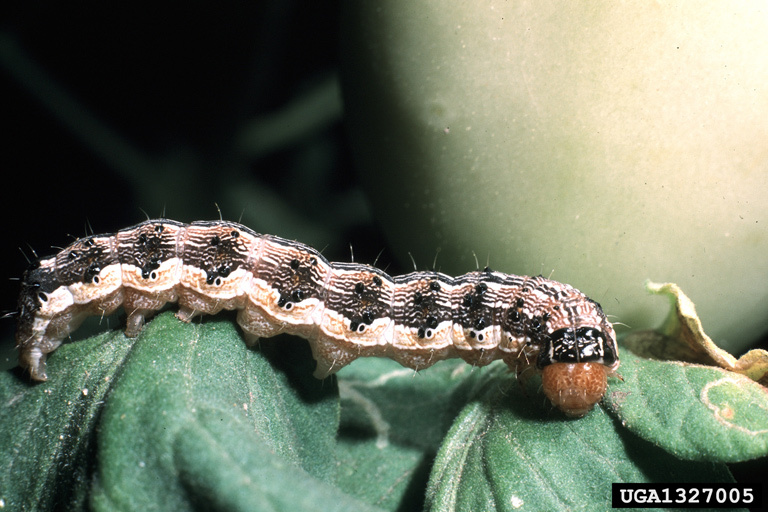
Late instar larva on tomato foliage

Tomato fruitworm feeding on fruit
Symptoms
Holes in tomato fruit, including entry holes near stem end; feeding turns inside of tomato into a watery cavity filled with cast skins and frass (insect feces); damaged fruit ripens prematurely; young caterpillars are cream-white in color with a black head and black hairs; older larvae may be yellow-green to almost black in color with fine white lines along their body and black spots at the base of hairs; eggs are laid singly on both upper and lower leaf surfaces and are initially creamy white but develop a brown-red ring after 24 hours and darken prior to hatching.
Cause
Insect
Comments
Management
Early treatment of tomato fruitworms is necessary as once they enter the fruit they are protected from sprays; monitor plants for eggs and young larvae and also natural enemies that could be damaged by chemicals; Bacillus thuringiensis or Entrust SC may be applied to control insects on organically grown plants; appropriate chemical treatment may be required for control in commercial plantations.
Category : Others
Curly top
Beet curly top virus (BCTV)

BCTV symptoms on tomato

Curly top symptoms on tomato
Symptoms
Young plants are usually killed by the virus; older plants are stunted and turn yellow to bronze in color with purple-tinged leaves; leave become thickened and roll upwards; leaf petioles roll downwards; green fruit turns red regardless of its age and becomes dull in color and wrinkled; plants do not recover form the disease and will not flower of produce fruit after infection.
Cause
Virus
Comments
Management
There is no resistance to Beet curly top virus in tomato so control relies on the management of the leafhopper vector; dense stands of tomato may discourage leafhoppers from visiting the plants; chemical spraying programs to protect against beet leafhoppers have been implemented in some areas of the US state of California ; in areas where the virus is a chronic problem, n areas where curly top is chronic, dense plant spacing, shading, row covers, and intercropping have been reported to reduce levels of infection.
Category : Nematodes
Root knot nematode
Meloidogyne spp.
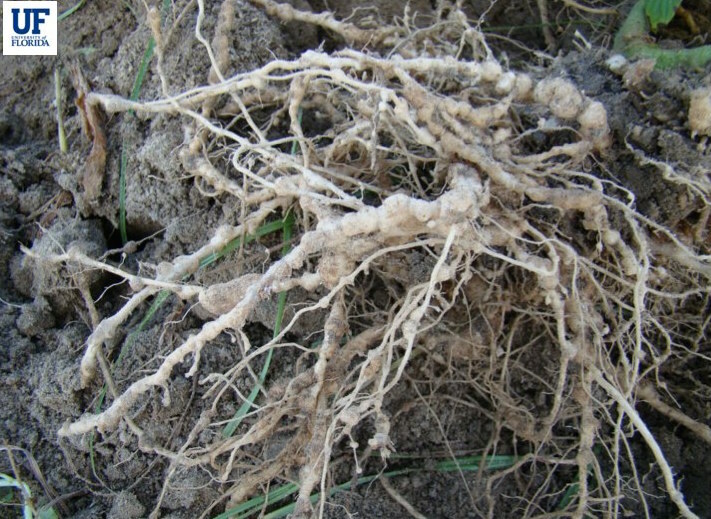
The characteristic symptom is the galling of the roots

Tomato plant dug up to reveal galling on roots

A close-up of a washed root from the field with large galls.
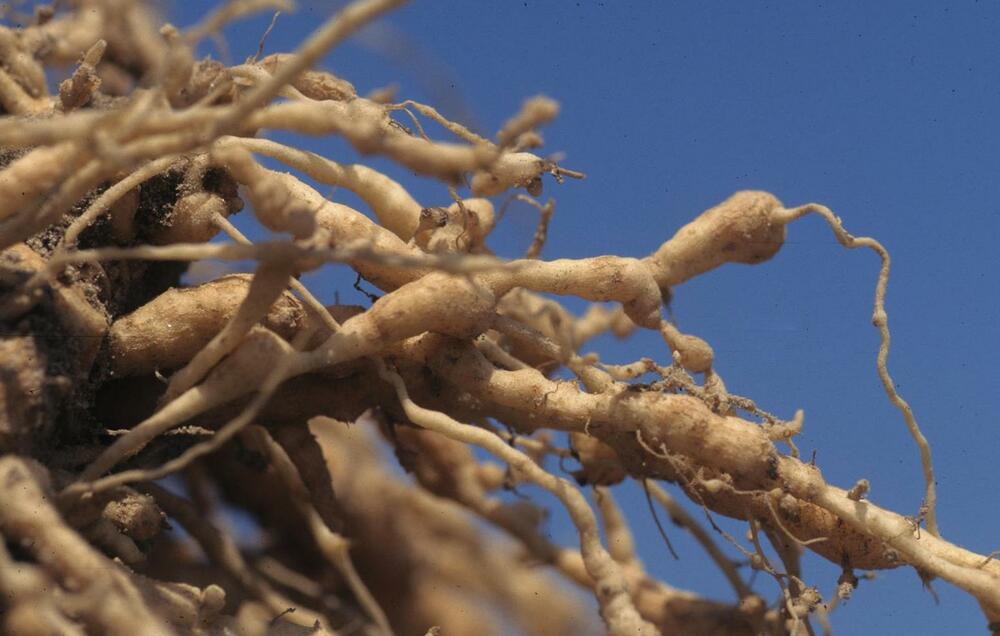
Extensive galling of tomato roots

Healthy tomato plant (left) next to one infested with root knot nematodes (right)
Symptoms
The characteristic symptom of root knot nematodes is the presence of galls on roots which can be up to 3.3 cm (1 in) in diameter but are usually smaller; galls cause a reduction in plant vigor; if the galls on the roots are extensive then plants may yellow and wilt, particularly in hot weather.
Cause
Nematode
Comments
Management
Plant resistant varieties if nematodes are known to be present in the soil ;check roots of plants mid-season or sooner if symptoms indicate nematodes; solarizing soil can reduce nematode populations in the soil and levels of inoculum of many other pathogens.
Category : Mites
Spider mites (Two-spotted spider mite)
Tetranychus urticae
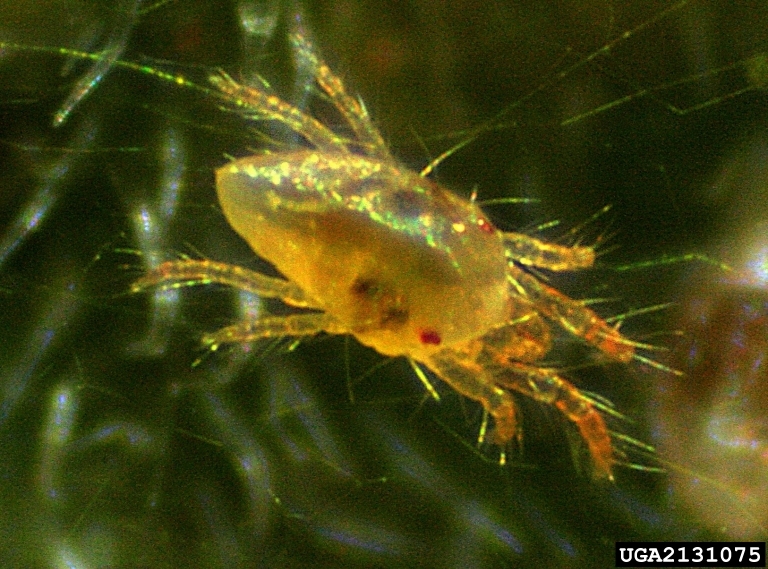
Spider mite adult
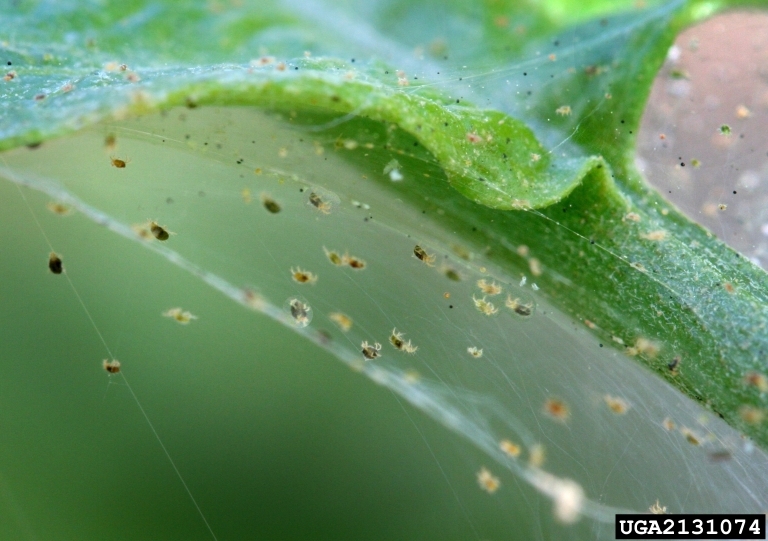
Twospotted spider mite (Tetranychus urticae) adults
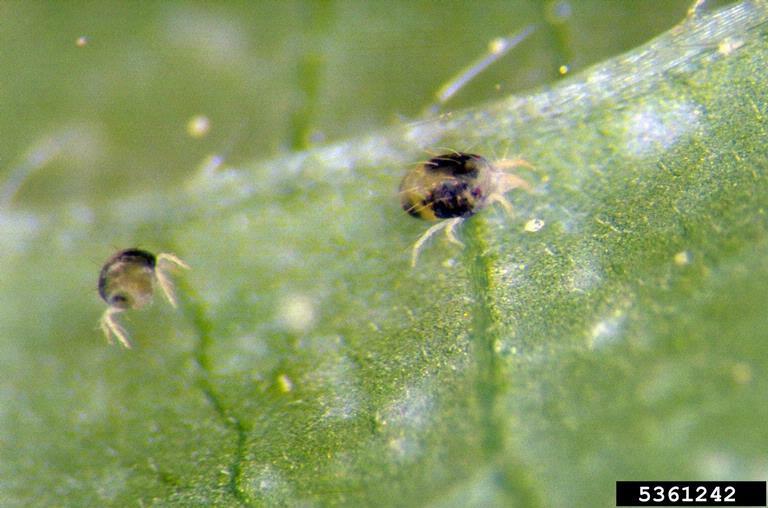
Close-up view of two-spotted spider mites (Tetranychus urticae)

Spider mites on tomato

Spider mite
Symptoms
Leaves stippled with yellow; leaves may appear bronzed; webbing covering leaves; mites may be visible as tiny moving dots on the webs or underside of leaves, best viewed using a hand lens; usually not spotted until there are visible symptoms on the plant; leaves turn yellow and may drop from plant.
Cause
Arachnid
Comments
Management
In the home garden, spraying plants with a strong jet of water can help reduce buildup of spider mite populations; if mites become problematic apply insecticidal soap to plants; certain chemical insecticides may actually increase mite populations by killing off natural enemies and promoting mite reproduction.




























































































































































































































































































































































